#it follows manga without any fillers
Explore tagged Tumblr posts
Note
Excited about Blue Exorcist coming back? it looks like a really interesting show
Ah, yes, yes! Actually this blog was originally dedicated to Blue Exorcist heck, the blog's name and as you see - as soon as it returned my brainrot became unstoppable 🤣
I really recommend it, especially the manga. It's a rare case for shounen when you have more than two plot relevant characters, when the female charas are independent and represent different types of strength, when the team's chemistry feels realistic and entertaining to watch. Also the romance is really nice and well written! Bless Katou-sensei! Started reading her work when I was like- 14 yo and she never disappointed my expectations.
As you see, so far I really enjoy the anime adaptation by Studio Voln. They're doing great!

Also I'm so sorry for my followers, but it feels like I gonna spam you with AoEx/Bonizumo content for a while. Please bear with me 😖💗
#it's a bit complicated to start with anime though#bc the second half of the first season are fillers with the original ending#and it's no good#so somewhere after episode 15-16#you need to drop everything#and start 2nd season aka Kyoto saga#it follows manga without any fillers#and then the new season#Inari arc is really good#starts with fun but plot twists and angst are coming
7 notes
·
View notes
Note
Hi, how are you? Let’s say I’m new to the Naruto fandom. I discovered the series when I was 12, but I only started following it recently. I started reading the manga not too long ago, but since I was 12, I’ve never liked Sakura. However, as I mentioned, I don’t know much about the story or the Naruto fandom, though I’ve noticed there are many toxic fans of Sakura and Sasusaku.
I have a few questions I’d like to ask because I really liked your perspective on many things. I must admit I feel a bit embarrassed and afraid of bothering you with my questions, which might seem a bit silly or even incoherent. But I’ve noticed you always present the facts clearly and show who Sakura really is. So, I wanted to ask if I could send you these questions without being a bother, especially since you might have already talked about or answered them before. Also, knowing myself, they would probably be quite a few and maybe a bit lengthy.
First Question:
Did Sakura really stalk Sasuke? I've seen many people claiming this, while others completely deny it, so I’m not sure what to believe.
Second Question:
Can the novels and databooks from the Naruto universe be considered canon to the main story? Once again, I’ve come across various opinions about this, and I’d like to understand how it works.
Third Question:
Is it true that Naruto almost harassed Sakura by trying to kiss her while disguised as Sasuke? I came across this argument in a video made by a Sakura fan, where they discussed the hate the character receives. I have screenshots from the video if it helps clarify this point.
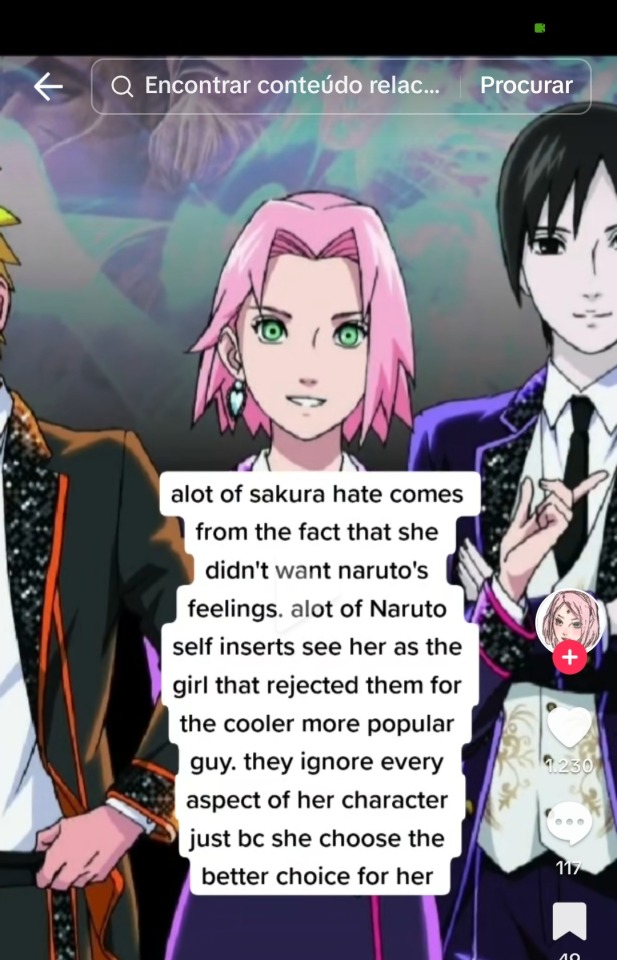

This is the whole screenshot for context.
Fourth Question:
Are many of Sakura’s accomplishments in the story real, or were most of them made up by her fans? I’ve seen discussions about titles and achievements attributed to her, but I couldn’t find confirmation that they’re true. Once again, I have screenshots of where I found these claims if you’d like to check them. (I also saw on the Naruto Wiki that one of Sakura's nicknames is "Second Tsunade." Is that really true?)
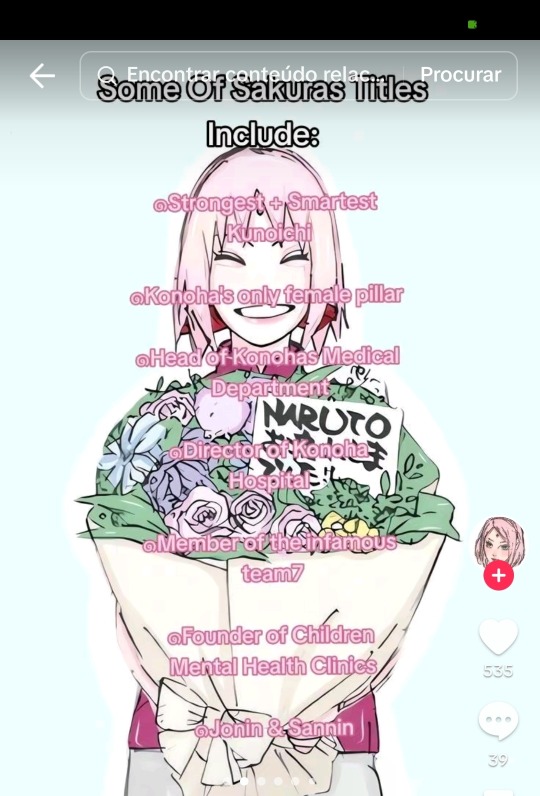
Since this is coming from a Sakura fan account, I highly doubt that it could be true.
To be honest, I’ll stop here because I’m feeling a bit embarrassed and don’t want to be a bother. Please only respond if you feel comfortable addressing these questions, as I know some of them might sound a little silly or incoherent.
If there’s any grammar mistake, it’s because I’m translating this using a translator, so the translation might not be perfect.
Hello!
Don't worry about your grammar, your ask is perfectly understandable.
First, welcome to the fandom! I really hope you enjoy this community and Naruto as a series.
Now, let's go bit by bits.
Did Sakura really stalk Sasuke? I've seen many people claiming this, while others completely deny it, so I’m not sure what to believe.
In the manga you won't see Sakura literally stalking Sasuke hence why some people deny she did it. However, in an interview Kishimoto called Sakura a stalker back in 2006
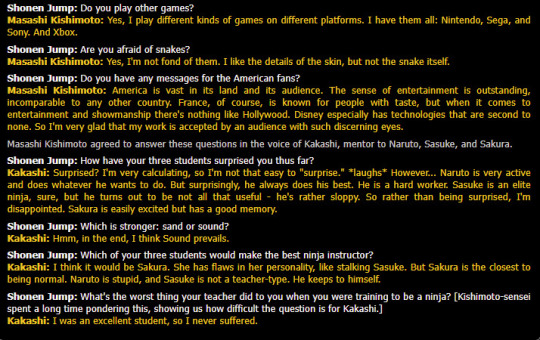
Can the novels and databooks from the Naruto universe be considered canon to the main story? Once again, I’ve come across various opinions about this, and I’d like to understand how it works.
The novels are filler, period. Anyone who tries to tell you they're canon are het!shippers coping that Kishimoto never gave them any official content for their ship so they have to settle for the filler novels.
People might think novels are canon because they're official content but there's a difference between official filler content (videogames, naruto filler episodes, novels and anything comissioned by Studio Pierrot and Shueisha editoria) and official canon content which is everything written by Kishimoto. They're both called official because even though filler has no impact on the story, it's still licensed/copyrighted content you need to pay to get.
The only official canon content meaning it's written by Kishimoto is the Naruto manga (700 chapters), Naruto Gaiden, Minato One-Shot and Boruto The movie.
Movies like Road To Ninja and The Last are hybrids in the sense that Kishimoto was involved in the projects creation but it was ultimately other people who contributed more to them and even started them.
As for the databooks, they're not canon either because Kishimoto didn't write them (he didn't have time to do so). The information you'll find in them often contradicts what you see in the manga. However, they're still useful resources because they contain Kishimoto interviews and a few comments here and there on the illustrations. You can read more about it here
Third Question: Is it true that Naruto almost harassed Sakura by trying to kiss her while disguised as Sasuke? I came across this argument in a video made by a Sakura fan, where they discussed the hate the character receives. I have screenshots from the video if it helps clarify this point.
No, Naruto did not transform into Sasuke to assault Sakura or trying to take advantage of her. Naruto transformed into Sasuke to ask her what she thought of him, Naruto, that's it. It was Sakura who tried to kiss Naruto thinking she was going to kiss Sasuke, Naruto did not initiate the kiss attempt and then he left because he got diarrhea.
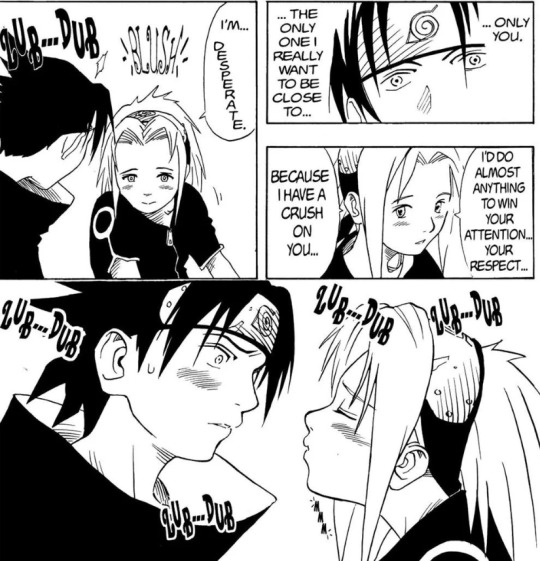
As for the assault, it's also Sakura the one that's extremely creepy towards Sasuke. Not Naruto towards Sakura. She's the creepy character.
Here she's thinking about Sasuke (it was actually Naruto) looking at her "with bedroom eyes"
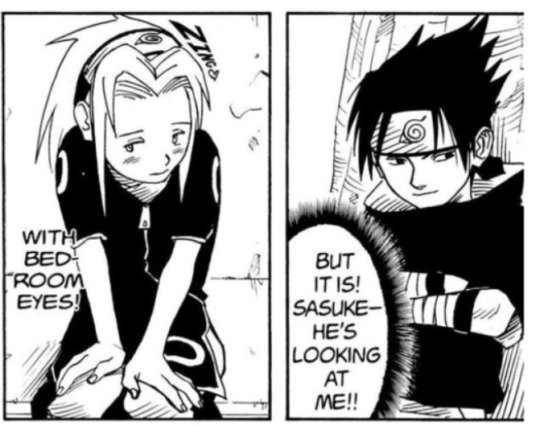
Here she's planning on how "overwhelm Sasuke with sex appeal"
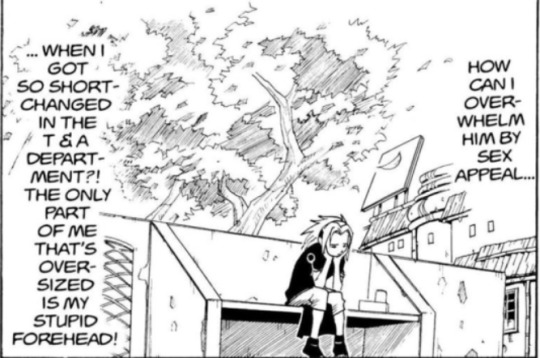
here she's thinking on how if Sasuke had to pee then she would've liked to see his penis.
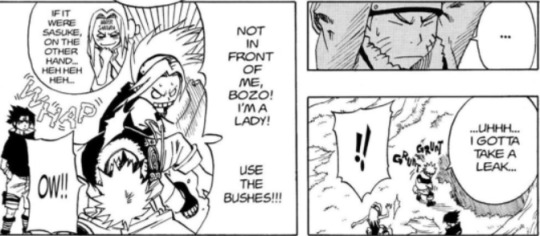
Fourth Question: Are many of Sakura’s accomplishments in the story real, or were most of them made up by her fans? I’ve seen discussions about titles and achievements attributed to her, but I couldn’t find confirmation that they’re true. Once again, I have screenshots of where I found these claims if you’d like to check them. (I also saw on the Naruto Wiki that one of Sakura's nicknames is "Second Tsunade." Is that really true?)
I'm gonna go based on the accomplishments listed on the screenshot you share.
-Is Sakura the strongest Kunoichi? No, this is one of the most pervasive talking points in the fandom to the point is treated like the truth but compared to Tsunade, who is stated in the manga to be the strongest Kunoichi that has ever lived, Sakura is defeated multiple times by enemies that Tsunade, managed to defeat or at least, harm. Tsunade managed to defeat both Kabuto and Orochimaru.
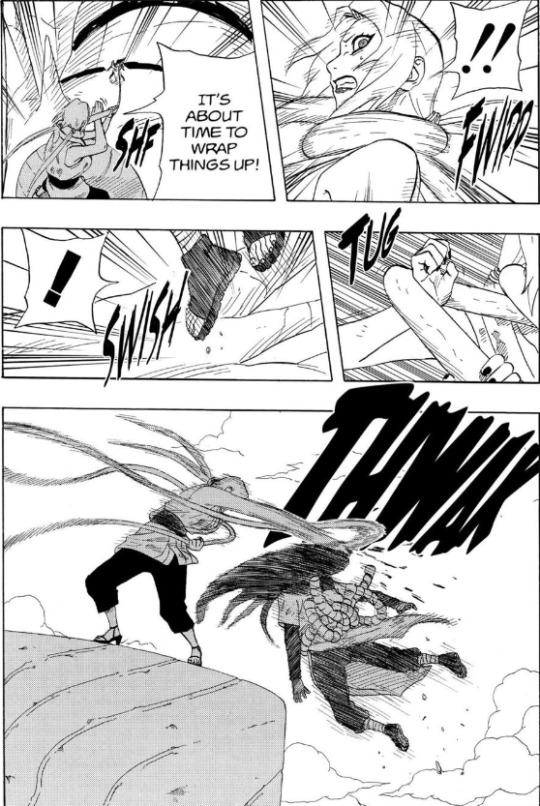
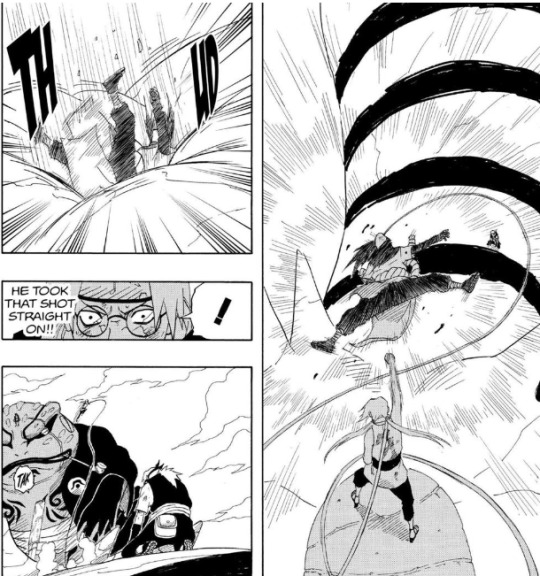
But Sakura couldn't do anything when she, Naruto, Kakashi and Yamato encountered Kabuto and Orochimaru and was rendered unconscious for the rest of the fight.
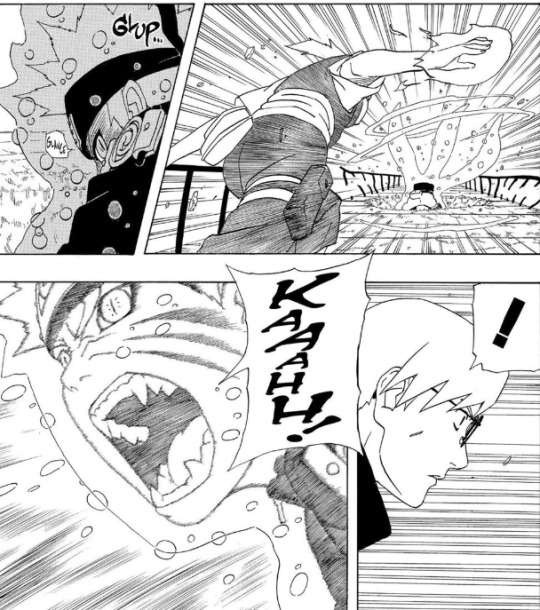
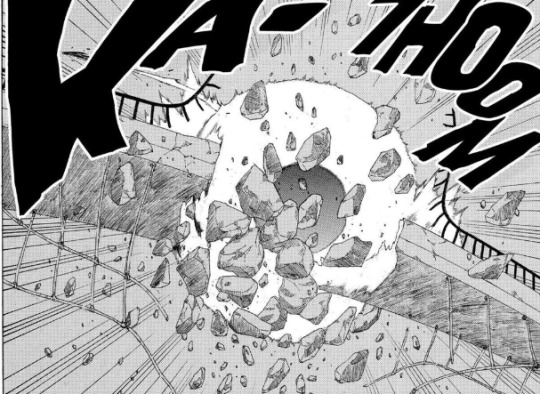

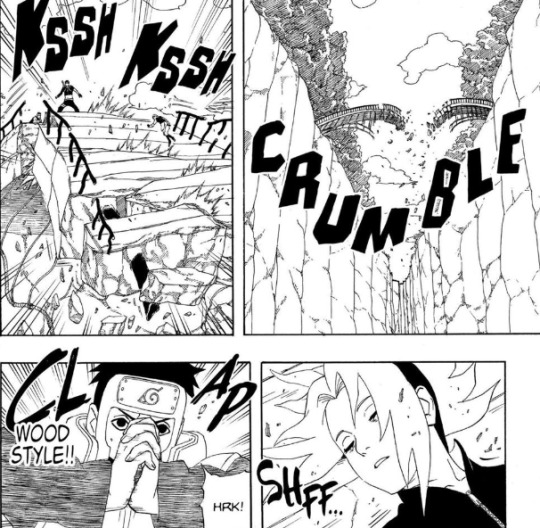
What's funny here is that even though both Kabuto and Sakura received the same impact, Kabuto did not lose consciousness. On top of that, Sakura had to be saved by Yamato
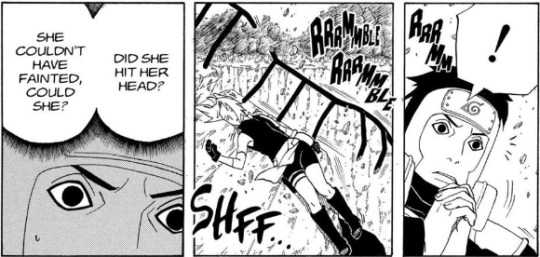
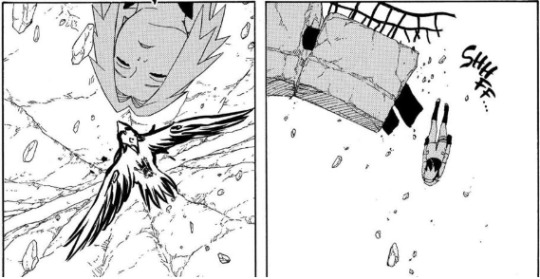

Sakura charged against Madara without a plan or strategy, doesn't even scratch Madara and then has to be saved by Naruto and Sasuke, Madara mocked her for this and called her "the side show"
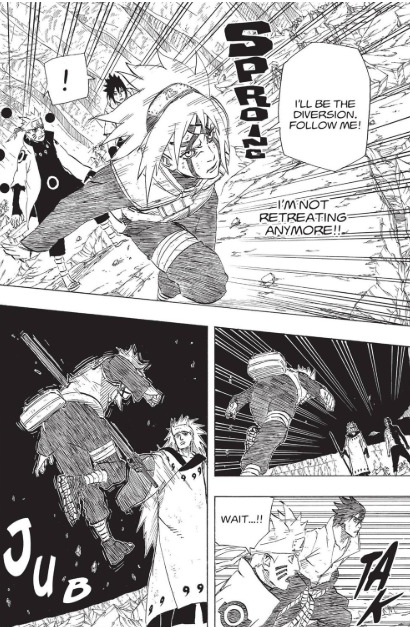
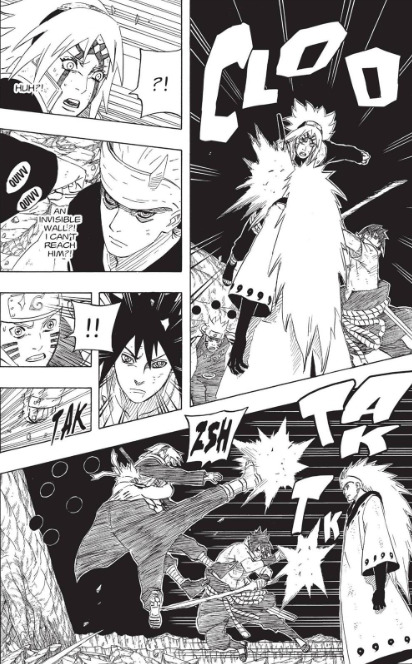
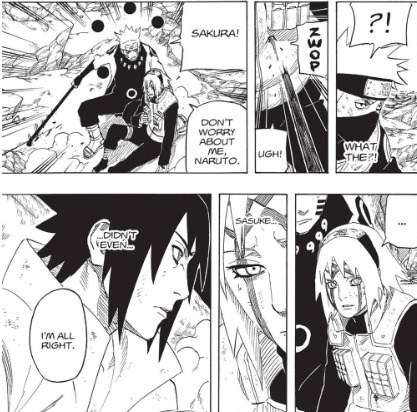

Meanwhile Tsunade was actually able to hit Madara
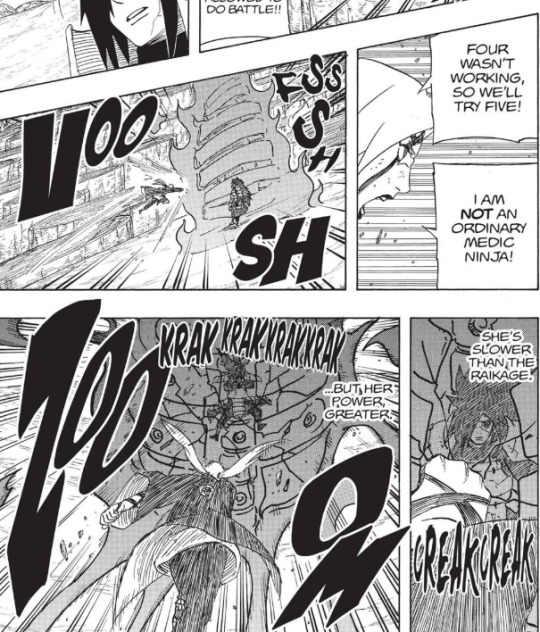


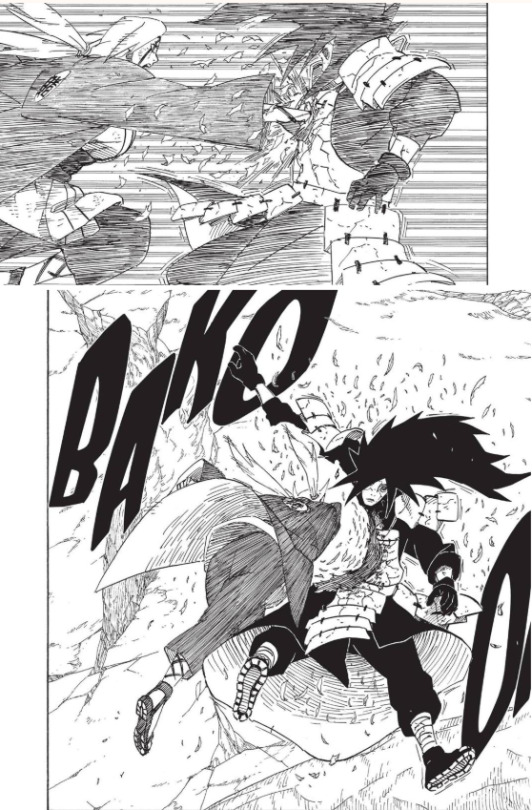
-Is Sakura the smartest Kunoichi? No, during the chuunin exams she was the only rookie who did NOT understand the written test. Neither the first part about the first nine questions nor the second part about tenth question. Everybody else did understand the first part of the written test and Naruto helped everybody pass the test by answering the tenth question that was more of a test of attitude/will than skills [LINK]. On top of that she's never able to come up with strategies to fight against an enemy. When Naruto and Sasuke were unconscious at the forest of the Death and Sakura had to take care of them, she could only come up with flawed traps the enemy spotted right away and when she attempted to fight the enemy she got beat up so bad, two teams (InoShikaCho and Neji, Tenten and Rock Lee) and Sasuke had to come to her rescue. When it comes to both bell tests, it was Sasuke the first time and then Naruto the second time who had to come up with strategies on how to take the bells away from Kakashi while she was just there.
-The screenshot calls her Konoha's only female pillar, I have no idea where they got that from. I don't know if they're trying to insert here in the Hokage/Shadow Hokage thing Naruto and Sasuke are, or what.
-Director of Konoha hospital, I think this is true.
-Member of Team 7, this is not an accomplishment. Iruka made the teams randomly, it's not like all Team 7 in shinobi history happened to be made up of the strongest ninjas and there's this requirement to be outstanding to be a part of team 7. It's a random made up team and Naruto and Sasuke ended up being exceptional shinobi, the greatest of all time actually. Sakura stans are just trying to make it seem like she's also a part of that.
By randomly I mean that Team 7 was created as a regular random team instead of an elite team where only the best of the best can enter, not that the students are randomly selected
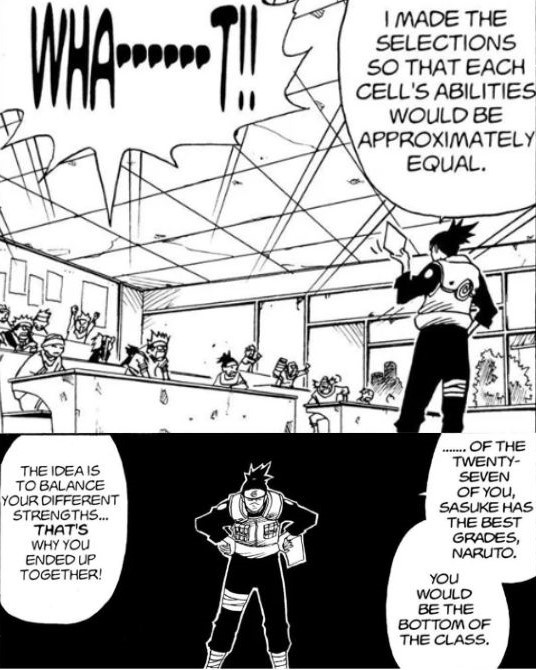
-Founder of Children Mental Health Clinic. This is false and comes from a filler novel. Canonically the character that opened up an institution to support orphan children is Kabuto, as seen in Naruto Gaiden

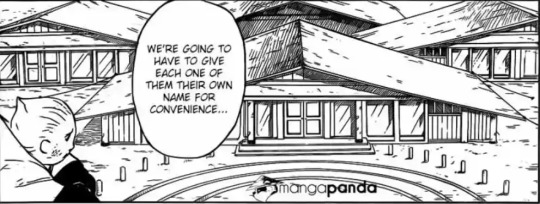
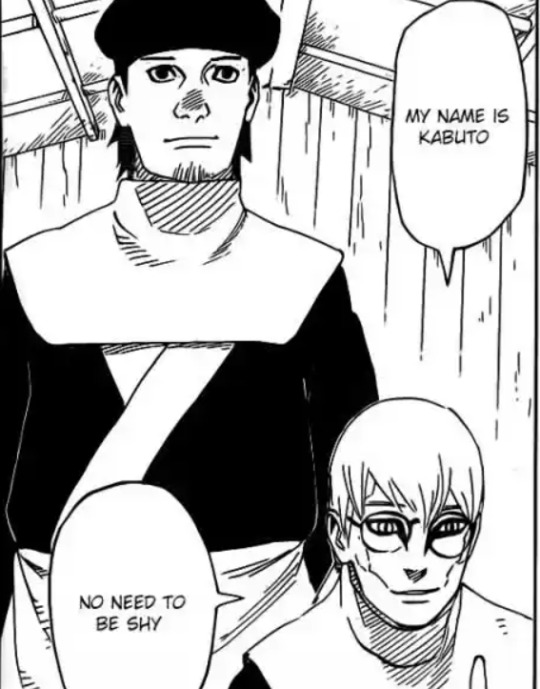
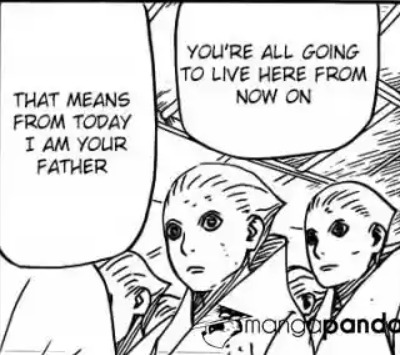
-Sakura is a Jonin and learned the techniques from Tsunade, a Sannin, but she, as far as I'm aware, did not come up with her own, which is what made the Sannin, well, the Sannin. Naruto and Sasuke were able to create their own techniques unlike her, though, like Rasenshuriken and Chidori Nagashi, respectively.
So, as you can see most of what's listed there are false made up accomplishments to try to make her seem like she's on the level of Sasuke and Naruto but in reality she's a pretty mediocre kunoichi.
Anyway, don't be embarrased to ask questions, we were all new to a fandom at some point and wanted our doubts and questions answered :)
53 notes
·
View notes
Text
One Piece Crack Ship War - Submission post!
Welcome to the One Piece Ship War - crack edition!
What is a crack ship?
A crack ship is a (in this case romantic/sexual) ship that has little to no basis in canon.
When will my ship qualify for this tournament?
They will automatically qualify (after having been submitted) when:
The characters involved have NO canon interaction*, and are not part of the same crew (no matter how popular the ship is).
The characters involved have 1 short canon interaction and less than 10 fics for them on AO3 (as a side pairing counts too)
They might qualify if:**
They have no canon interaction but are part of the same crew or organisation.
They have 1 short canon interaction but more than 10 fics on AO3
They have 1 long canon interactions or 2/3 short ones and less than 10 fics on AO3
They have multiple canon interactions but NO fics on AO3
It's an incredibly funny ship (but you gotta convince me it's crack!)
These ships will not qualify on principal:
ANY ship between Strawhats (honorary Strawhats don't count if they haven't met a certain Strawhat - examples: BrookNami does not qualify, SanjiVivi does not qualify, but BrookVivi would qualify)
The top 25 ships (or something, be sensible) on AO3.
*canon interactions include fillers, cover stories, specials, and movies (though I haven't seen the last 2 yet and I don't remember much of the other ones, so these might slip through, but I'm counting on you to honor this rule). Also, I won't know nor check interactions in the manga (that haven't been animated yet), so something might slip through there as well. Just honor the rules, please.
**Any ships in the 'might qualify' category will be judged on crackyness by me first, and when I'm in doubt, I will put them up for a vote - so expect a few polls for this.
Rules!
All characters must be from One Piece (no OCs).
Must be a crack ship according to above guidelines.
Ships that were in the previous shipping war tournament are allowed in this one too, as long as they follow the previous rule.
No moral limitations. These are fictional characters, not real people. Go wild. (But be prepared for 'problematic' ships to be voted out in round 1 or 2.) I will not start discourse/moral discussions about any ships! (messages about morally questionable ship are likely to be ignored and deleted)
Poly ships are allowed! I will cap them at 5 characters, however, and at least 1 character should follow the interaction rules stated above. (examples: JinbeRobinBrook or KidLawLu are not allowed. RobinNamiKiller would be allowed, on grounds of Killer having no interactions with the other 2 (I think? 😂)) Again, be sensible here.
All characters involved have to be humanoid. No concepts, objects, or full animals (fishmen/merfolk, minks, and Chopper are allowed).
You can submit multiple ships, but use a new form for each ship.
Do not hate on other ships, just support your own.
You are allowed and encouraged to submit fanart! As a lot of these ship won't have official art with all characters in it, it will come down to fanart for the most of it ((bad) edits are also very much allowed). However, it needs to be your own or you need permission from the artist before submitting it! However, if you haven't gotten permission yet when submitting, you can always send me a link to the fanart later. Without picture submitted, there might be a chance your ship will have to compete without a picture.
Keep the main images SFW and spoiler free. Propaganda can contain nsfw stuff and manga spoilers, as long as it's announced up front (eg: [Spoilers ahead]/[nsfw ahead])
Submit only through the google form below. Submisions through asks or reblogs will not be accepted.
Read the rules? Go ahead and submit those ships! (<you can click on that)
Oh yeah, and in case you're wondering... All submitted ships that pass the crack ship bar will make it into the tournament! No limitation on how many contestants there will be or how many submissions a ship needs. I want this to be an opportunity for all to discover new fun and silly ships!
Closing date is april 8 at 10AM CET.
#one piece#tournament#ship war#op crack ship war#submission form#sorry for the long post but I feel like this needs a lot of clarifications#I might change some details later if something comes up in asks but this is it for now#as always don't hesitate to send an ask if anything is unclear/you're in doubt about anything
103 notes
·
View notes
Text
I wanna know what Ikkaku knows about Urahara:
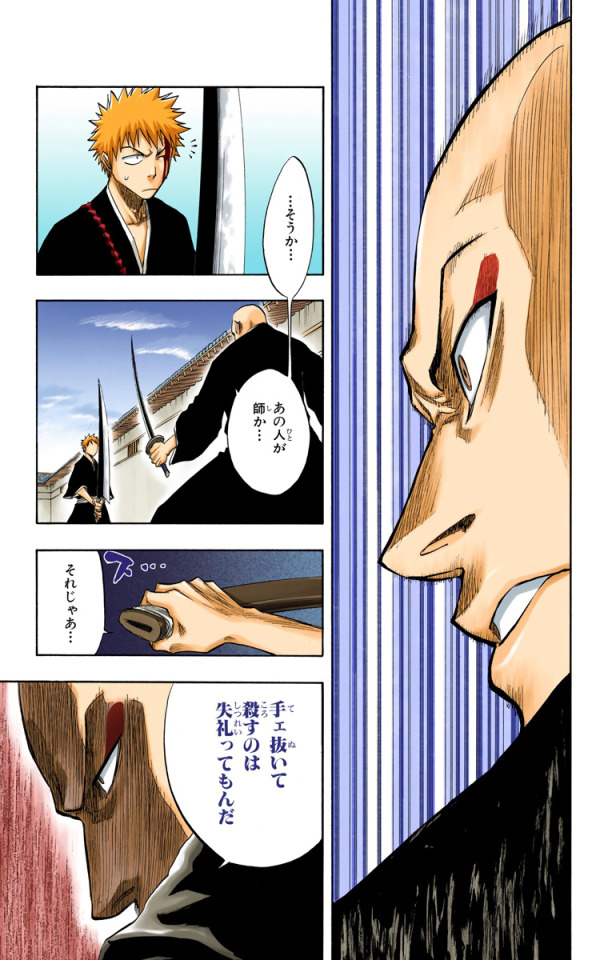
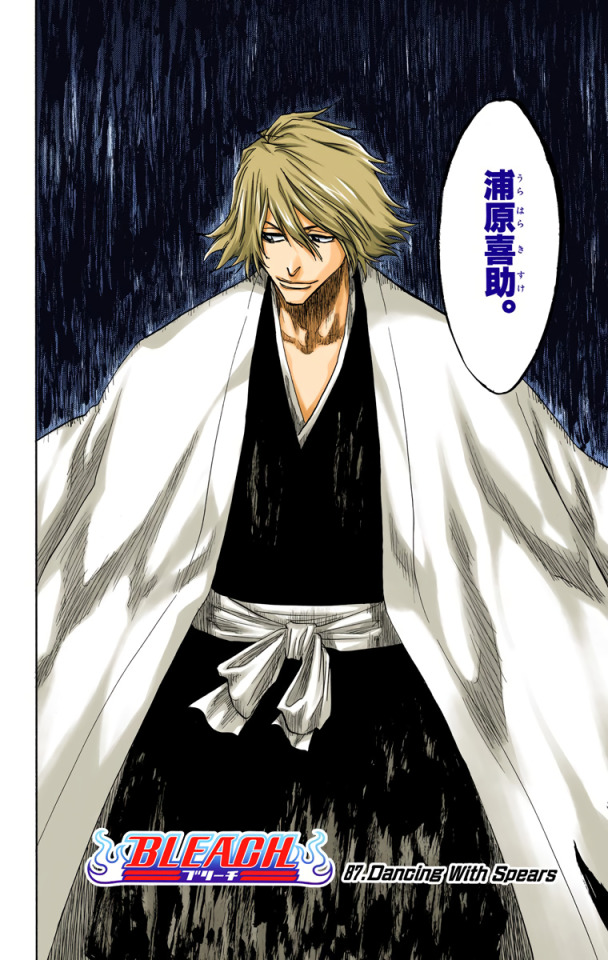
[Bleach 087]
Like, do they... know each other? The visual suggests that someone in the scene knows Urahara was a captain, and it sure ain't Ichigo. So I feel like we're meant to understand that Ikkaku knows this.
Urahara's name also holds weight in terms of Ichigo's viability as an opponent, which suggests Ikkaku knows Urahara as someone other than some rando criminal, or just as a Mad Scientist type. It's Ichigo's movement that impresses Ikkaku, not his strategic craftiness.
I don't try that hard to keep the Gotei's 20th Century straight in my mind, but we do know that during TBTP Zaraki wasn't 11th Captain yet, and therefore Ikkaku may not have been in the Gotei at that point then, ether. (There's a whole dispersal of 11th backstory filler eps, which I've been assuming aren't in the manga in any form, but who knows, maybe some of this backstory info also holds true here, too. In the anime, Ikkaku and Yumichika follow Zaraki into the Gotei.)
In any case, apparently Ikkaku has a whole Seireitei family (see: TYBW), so maybe they were well-positioned for all the hot TBTP goss regardless of whether Ikkkau was enlisted at the time.
Or does everyone just know who Urahara is? Obviously, he's a poorly kept secret at least as far as his outpost goes; he's made a whole business out of it. But if Rukia knew he'd been a captain she doesn't harp on it.
And if there's something you can count on me for, it is knowledge of random-ass Hitsugaya panels:

[Bleach 237]
Hitsugaya says he doesn't know who Urahara is. Well, he's heard the rumors about Urahara, but says Urahara is someone whose true nature can't be ascertained. He probably does know what Urahara used to be a captain. He's heard that he's formidable, and probably isn't someone to let your guard down around. Which, really, is all the things we know Ikkaku knows about Urahara. Hitsugaya's just not willing to extrapolate further based on rumor alone. Maybe Ikkaku is.
But based on how Urahara's name influences the way Ikkaku chooses to fight Ichigo, I feel like Ikkaku is not operating solely on rumor, either. Someone's battle prowess/skill as a mentor doesn't seem like something he'd accept without firsthand knowledge, even if he's willing to roll with it for other stuff. So I feel like it's perfectly defensible to argue that even if Ikkaku wasn't actually in the Gotei while Urahara was in the picture, he still had an ~encounter (and probably not while Urahara was in his Innocent Shopkeeper era).
Maybe Ikkaku ran into Urahara in the woods when Urahara was off making an impression on Kuukaku [1][2]. Or Ikkaku's Seireitei family sic'd the Onmitsukidou on him while he was off playing hooky in Rukongai! Tons of fun possibilities!
Of course, this raises the time-honored question of what, if anything, anyone in the current Gotei knows about TBTP. Because it really seems like they know nothing, and didn't even know there was something to not know. But for a lot of them that might be an effect of their willingness to pretend they know nothing? So I feel like you could go in a lot of directions with that. Not to have blorbo disease again, but Hitsugaya seemed like he was learning Vizard Lore in real-time during the Winter War, so apparently it's not like, part of some kind of Area 51 folder you gain access to when you become a captain lol. YOU HAD TO BE THERE. (BUT ALSO SOMETIMES NOT EVEN THEN)
#i just think it's wild we get this urahara info from ikkaku#who is self-professed about not caring about rukia or being involved with any of this shit in any way#it's fun to think about how characters who really have no connection or interaction in canon relate to each other#i mean ikkaku is off-panel for that hitsugaya rumination; he is technically there#but we don't *see* anything between him and urahara#now i'm curious about it!#madarame ikkaku#urahara kisuke#bleach headcanons#bleach reread 2021#bleach manga#bleach カラー#no brain just bleach#and that's the end of vol. 10!
64 notes
·
View notes
Text
Neji Hyuga and Hyuga Clan Head canons
NejiTen Head cannons | Tenten Head Cannons | Nejiten Family Head Cannons
Alright, let's talk about the Hyuga Clan. There are still a lot of plot holes in terms of how the clan actually functions in certain ways as well as the whole genetics situation. My head cannons are strictly based on what is already established in the anime/manga. Kishimoto seemed to have jumbled some details together especially during the war;
What is Cannon that we can all agree on: 1. The Hyuga clan is the most prestigious clan in the Land of fire. Somewhere down the line, the Uchiha clan is related to the Hyuga clan (as explained by Kakashi during the chunnin exams when trying to tell the children about the byakugan...this is the first plot hole tbh) 2. Pre-war, there are two branches to the Hyuga clan; main branch (where they are unsealed and are involved in politics, and branch (the sealed, and protectors/bodyguards/serve the main branch. Main branch members may not become clan leaders or be involved in politics). 3. Post War, it is unclear however, heavily implied and then addressed by Hiashi that Naruto had a great influence on changing the structure of the Hyuga clan; there may be no such thing as the main and side branches, which means that the curse seal may no longer be in practice. However, it is just assumed since Neji is dead (based on this, it is possible that Neji's children would not be branded with the seal). 4. Birth order holds heavy meaning; Hiashi was the first twin to pop out, so he was part of the main branch. Hizashi was the younger twin and was branded for the side branch. 5. For Hiashi Hyuga, leadership of the Hyuga clan is at the digression of the current clan head; Hiashi chose Hanabi over Hinata to become head of the clan. 6. Hyugas can marry outside of their clan. We see this with Naruto and Hinata. It also worth saying that we do not see Hinata and Neji's mother's eyes in both the manga and anime (here's the other plot hole for Hyuga lore). If the Uchihas are distantly related to the Hyuga's, the mutation had to occur due to a mix of genetics outside of the clan (again, it's as if Kishimoto fucking forgot he had Kakashi explain that the Uchihas and Hyuga's did share a line at some point and pulled a fast one during the war to try and explain everything, but it fumbled the lore even more.) 7. It is possible for a Hyuga to not have the byakugan. There was a filler character who only had one byakugan eye. Himuwari also does not have the standard Hyuga eyes. This can also be related to the Uchihas if we are following the genetic line; the Uchihas activate their sharingan, just as Himawari activates her byakugan Here are my Hyuga Head Cannons: 1. The byakugan is a dominate gene. Due to the fact that we see that characters can have the kekkei genkai without having the signature eyes, it is possible that the two Hyugas who possess the byakugan can have a a child who does not have it and vise verse; BB, Bb, and bb traits for the Byakugan. Based on the traits, the child could also not possess the byakugan at all due to the bb recessive trait. A child with a mixed Bb gene may not have the standard Hyuga eyes until the Byakugan is activated like Himuwari. 2. All marriages must go through the clan head for approval/blessing. To keep the prestige of the clan nice and clean, it wouldn't be surprising if there needed to be some screening process or request made in order for a Hyuga to be married. Even if the marriage is between clan members. 3. Arranged marriages are based upon request. If a Hyuga clan member has not been approved for any self-picked marriages, the head of the clan may be inclined to suggest an arranged marriage. It would be more for the main branch of the family instead of the side branch. 4. Hiashi Hyuga already started implementing some change to the Hyuga can after the death of his brother. The guy was traumatized when Hizashi took the L for him, Hiashi was probably fighting with the elders on traditions and policies that in order to prevent something like that happening again. He also saw how traumatized Neji was upon seeing his father's corpse. It is possible the Hyuga elders and Hiashi held tension after the death of Hizashi, which prompted the lord to go against the birth order rule (by making Hanabi the heir to the clan instead of Hinata due to competence and potential) Allowing Naruto and Hinata to get married was one of the biggest changes to the clan due to Naruto's connection with Neji.
Okay, onto my head cannons for our bestest boy <3

Neji's mother died soon after his birth. We see mostly Hizashi with his son in the manga and anime, and there is no mention of a mother, but I feel as though one of the main reasons why Neji had such a strong bond with his father was because his mother was not there. His mother could have also have been a distant cousin of Hiashi and Hizashi in order to maintain the dominate byakugan gene.
Hizashi remarried a civilian to take care of Neji. As much as I would love for Hizashi to be a single dad, it would make sense that he would remarry someone who was not a shinobi in order to look after Neji when he was on missions or handling clan duties with Hiashi. When Hizashi died, we see a woman sitting besides Neji, to whom we can assume was a mother like figure for him (that or a cousin...) Neji’s step mother is named Shizukana Hyuga.
Neji's stepmother is well taken care of by Hiashi. I would like to believe that Hiashi held a lot of guilt and pain over his brother and in order to rectify the situation in some capacity, he took it upon himself to become financially responsible for Neji and his step-mother. He sends money quietly, not wanting to make a big deal about his support, which can be why Neji is able to live comfortably...which goes into;
Neji and his stepmother do not live in the Hyuga compound. With the mess of the main and side branch conflicts, it would be an interesting notion that many side branch members moved out of the main Hyuga compound; only the main branch members as well as branch members who directly service the main branch (we have seen the Hyuga maids in the anime...it's wild to me that the branch members are employed in such a way, but hey. It is what Kishi wrote. It reminds me of how in a monarchy, you have the queen's attendants). Neji's house is probably located somewhere around the proximity of the Hyuga compound, however far enough that there is some separation.
Neji refers to his stepmother as "mother". Following the head cannon that his birthmother passed away, Shizukana was the only other figure Neji had maternally. He is aware that she is not his biological mother, however still holds her in some high regard.
Shizukana shows great favor in Neji spending time with Tenten, in fact, she was able to get Neji to acknowledge his feelings towards her. Neji probably didn’t have to say anything when he would bring Tenten around her. Neji made it obvious he had a crush, just as Shikamaru had observed. Where Shikamaru and the guys would tease him, Shizukana was rather straight forward in talking to her son about Tenten. Neji had a hard time explaining himself to his step mother.
Neji is obviously protective of Hinata, but when it comes to Tenten, Neji will try his best not to hover over her. His role as protector is hard to maintain when you don’t want your girlfriend to be mad at you for being over protective. In the words of Megara from Disney’s Hercules; “I’m a big tough girl, I can tie my own sandals and everything.” This scene can be paralleled with how I see Neji and Tenten interacting, minus the seduction part.
Neji is always completely honest with Tenten. He would never lie to her because there was no point to. They needed to have a trusting partnership in order to function properly but he was also grateful that Tenten did not judge him even in his darkest of times.
Neji will rarely say no to Tenten and Hinata. For Hinata, that is his sister (technically) and he may still feel a sting of guilt after all those years of treating her like absolute trash. Hinata had forgiven him, but he worked hard to repair his relationship with her; he was happy to have a younger sister to protect. For Tenten, in the anime and video games we see that Neji does not say no to her when she suggests to go places, or partake in whatever shenanigans she wants to set out on. He says yes to her automatically most times.
Neji is great at handling Tenten’s temper. She’s a bit hot-headed, especially when it comes to Gai and Lee. But Neji is able to keep her grounded and makes her feel validated in her feelings.
In Neji’s Ninja journal, it is cannon that he writes about Tenten. In the light novel, Hinata shows Naruto a few lines of Neji’s journal, one of the lines is a vow of Neji trying to make sure Tenten does not get depressed. It wasn’t expanded on, however I’ll assume that he does write about her from time to time; whether it be for sparring or just to record his thoughts about her.
Neji admire’s Tenten in many ways; mostly how she handles Gai and Lee. In one of the video games, Neji attempts to compliment Tenten (and fails because he’s awkward as fuck) on how she is able to manage both green beasts with suck ease. In a way, she is like the mom friend to the team in keeping them in check. Neji also has nothing negative to say about Tenten in cannon and even allows her to assist him in Hyuga matters (like when Hinata got snatched up during the first round of chunnin exams).
30 notes
·
View notes
Text
Keystone-Ranking My Hero's Academia's Arcs
To All my Friends and Followers, I am proud again to announce another double milestone. Not only have I reached over 10,000 total posts on this blog, but I have reach over 3,000 followers. Who would have guessed this little blog I made for fun would have made it this far? Because I am frankly flabbergasted that this blog has made it this point. I thank all of you for your support and truly wish that I can make this blog something worthy of your dedication. For this momentous milestone, I once again decided to do a massive project. This time, it will be ranking all the arcs of My Hero Academia.

So before I begin, let's cover some ground rules:
-What I will be considering an arc, as well as where it starts and ends, will be defined by the Wikia, making for a total of twenty one arcs.
-This will mainly be focusing on the manga. While I will mention the anime here and there, it will not play any major role in how I rank these arcs.
-This ranking will be relative to the rest of the series. So if I put an arc lower on the list, I'm not saying it's the worst manga as a medium has to offer, just not up to the standards of the series.
-This will be a series of pros and cons covering each of the series with some notes. This will involve a lot of generalizations and summarizations of points, as well as maybe skipping out on what I don't have much to say, but is the easiest way to get my thoughts across.
-This will be looking at the arcs without the context of later ones. I will review the arcs on their own and will only consider what has happened before in the story when that arc came out. That means that certain events will not "ruin" arcs retroactively, but can be held against the arc they happen in.
-The Final War Arc will not be covered here. Not only because that arc is not completed at the time or writing, but is far longer then any other arc in the story and has so much to cover with it, feeling like there are several arcs going on all at once. Even if it was done, I would still cover it on it's own.
Without further ado: the ranking of My Hero Academia's Arcs.
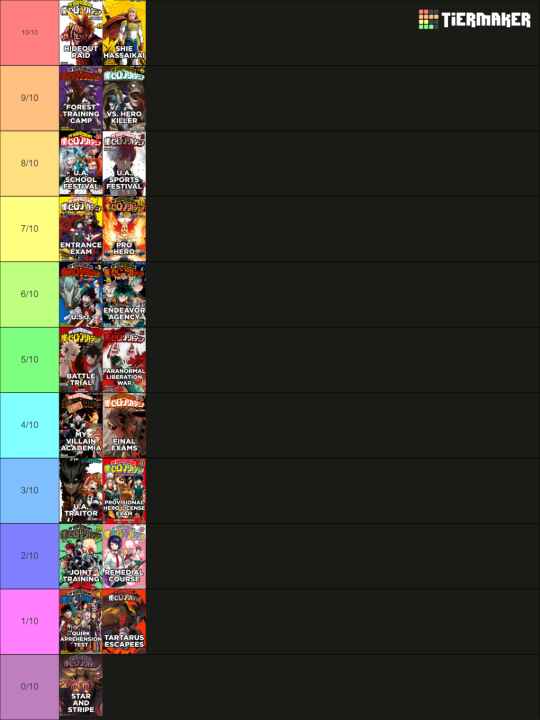
Stars and Stripes Arc: (0/10)
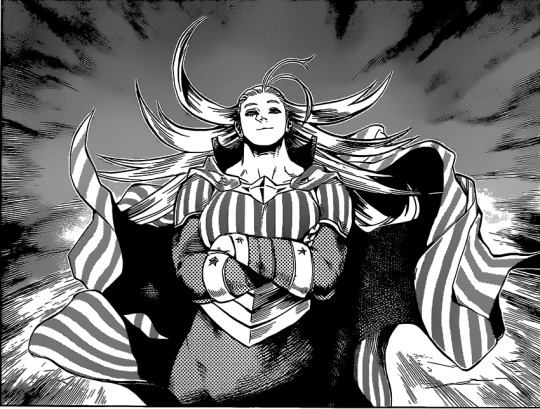
-This entire arc is built around Cathleen, a one note character that doesn't have any interesting traits or arc. She was never established before, even when she should matter to characters like All For One and is suddenly the most important hero currently active.
-My worst fears are confirmed that Tomura is nothing more than a meat puppet for All For One. All his unique traits and character is under lock and key for this entire arc, leaving us with a very bland villain that I have no interest in reading.
-The whole fight is a forgone conclusion. Tomura can't lose because he's the main antagonist who is next to unkillable and he can't get "New Order" because then he would be way too powerful to beat, robbing the arc of any tension it tries to have.
-The fight itself is not interesting, which is a problem when most of this is a fight. It's Tomura getting ragdolled over and over again while Stars and Stripes keeps using her Quirk in a lot of empty spectacle. No real cleaver plans, just slapping each other back and forth.
-All these factors together rob any emotional investment a reader may have had in the story. So in spite of it only being seven chapters long, it feels like a total slog to get through, simply waiting for canonical filler arc to be done with so we can move on.
-"New Order" is a slap in the face to the entire power system. It's such a vaguely defined ability with what it can actually apply with its rules. It felt more like Tomura was fighting a wizard from a whole other series, adding on to the various frustrations in this fight.
-The main consequences could have been replaced with a single chapter. Just have Tomura writhing in a cave over his body rejecting "All For One" and have Nezu analyze and pick up information on him from the footage of the PLF War. It would have been so simple.
-The actual consequences of this arc are minimal at best. You could honestly skip this arc and not really miss much in the grand story of the series. Again, making it feel like a filler arc. It makes this whole outing seem wholly pointless in the broader narrative.
=I've said my peace on this arc many times over. I struggle to think of anything good about it. It was a chore to read the first time and it took so much willpower to not turn this into another giant rant. I honestly hope I never have to go through or think about this arc again.
Tartarus Escapees Arc: (1/10)
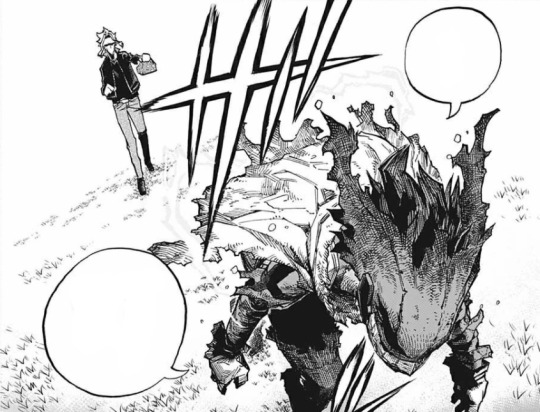
+I like the idea of this arc. Having Izuku regress into his self-destructive tendencies and isolating himself is a really good way to go with his low point. And this is well conveyed in the art, both in and out of costume, which I just want to is really solid this arc.
+Uraraka's speech was certainly a highlight. It's a great moment in her own arc about understanding and wanting to truly save people and gives her the relevance she has so desperately needed. Ending it with the narration of everyone being a hero was a good bit.
+I liked a lot of the bits with Stain, especially his talk with Toshinori. Having Stain, the man who misunderstands All Might the most, gives him the peep talk he needs to get out of his funk.
-The reaval of "Fa Jin" was such a massive miss for me. Not only does it not add anything to Izuku's arsenal outside of hitting even harder, it undermines one of the most interesting fights the series has had thus far by overpowering his enemy rather than outthinking them.
-There is little lasting consequences for some of the characters. Endeavor is an abuser that made a serial killer and Hawks killed a villain in front of everyone. They both say they're getting work done and everyone kind of moves on from it without issue.
-The concept of Izuku cutting off everyone around him, while interesting, wasn't anywhere near fleshed out enough. It's only a single chapter of him on his own before he's saved by the rest of Class 1-A. Kind of makes the arc's name feel like a misnomer.
-Bakugou's apology feels rather hollow given the actual phrasing and the lack of any kind of real response for Izuku. This extends to All Might, but to a lesser degree. These two are the most responsible for Izuku self-destructive mentality and it is quickly brushed to the side.
=Another arc that I've talked about before, but none of the good parts of. I think it's well above something like the Stars and Stripes up, but it's lack of real payoff for so much that was set up really shoots this all the way to the bottom of the list.
Quirk Apprehension Test Arc: (1/10)

+Aizawa has a solid character introduction and effectively sets him up. What seems to be a lazy bum actually hides one of the most strict and dedicated heroes in the entire series. A seemingly rough, pragmatic disciplinarian with a secretly good heart underneath.
+Having Izuku need to work under Aizawa was such a good move for his first day. He really learns just how much of a problem his power is going to be and how much personal responsibility a hero has. It's a good splash of cold water to Izuku's relentless optimism.
+This is the arc where we get Izuku taking on the name Deku. Not only is the moment around it cute and gives us his official nickname, but I like how it starts the trend of Izuku redefining his life, taking the mocking nickname, and making it the name of a real hero.
-The arc is strictly business, for lack of a better phrase. We don't get much expansion on the characters we know about or understanding of the other characters or their powers in spite of the fact that this test would have been the perfect place to introduce them to us.
-All it really has going for it is the one moment of Izuku throwing the softball with his finger. The ultimate, emotional climax is a character flinging a ball really far. I know that sounds like I'm being facetious, but there isn't a lot else happening in the arc worth talking about.
-We do get the early main trio of Izuku, Iida, and Uraraka interacting, but there isn't enough to go off of to get a real sense of their dynamic and characters outside of the basic traits we already established. Maybe how they view each other as people, but that’s about it.
-While the threat of expulsions is threatening for the characters, it's pretty empty from a meta perspective. We know that if Izuku was expelled, the series would be over. The reveal of the test being a ploy does give Aizawa some character, but makes it feel a little pointless.
-In the end, I'm not entirely sure what the point of the arc was. At least, enough to make it its own standalone story. Sure, Izuku develops the finger flicks, but that could have been shuffled to one of the other two arcs after this one and it would be fine.
=An arc that's ultimately a victim of its length. If it was tied into the arc proceed or succeeding it, it would have been fine. On its own, it doesn't really offer much value. I still think it has its points, but not enough to reach past this lull in the series.
Remedial Course Arc: (2/10)
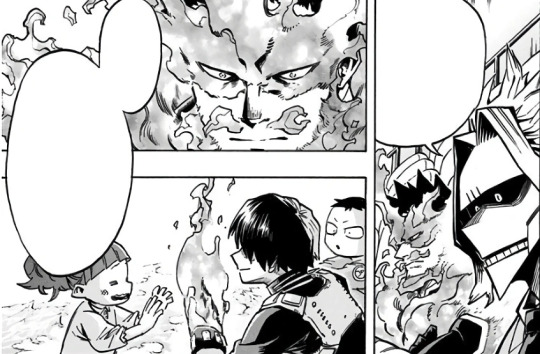
+The interaction between All Might and Endeavor was great. Yeah, a lot of people forget that happened this arc. Endeavor is uncertainty of what to do and turning to his rival is good in it's own right and works as a good springboard for Enji's arc going forward.
+The other character work was fine as well. Bakugou learning to be less of jerk to people as he learns to deal with a younger version of himself is nice. The Shoto, and to a lesser extent Inasa, stuff wasn't as prevalent, but I think it's a good steppingstone in his character.
+I like the one-off chapter with Aoyama and how he connects himself to Izuku and how much their Quirks can cause issues. Giving a minor character like this a one-off chapter like this is a good way to flesh out these characters without taking up too much time.
-Speaking of important stuff, this arc introduces the Quirk Singularity. For what turns out to be such an important idea, I don't think it does the best job building the groundwork. Like there wasn't enough set up to it before or in this arc for it to make sense.
-This arc is very much removed from the rest of the story. I wouldn't mind that but doesn't really give us much in its place. Outside of the few bits I mentioned before with Bakugou and Endeavor, it doesn't feel like it adds much else to the world or story.
-A lot of this arc is more comedic. If the comedy doesn't work with you, it's going to wear down on you fast. Outside of one or two bits, I found myself stone faced at a lot of the gags. Which is really odd because I do think Hori can do comedy, but it's not done well here.
-These two issues create this odd back and forth with the arc. The interesting moments are either small or side pieces while the actual meat of the story feels superfluous. So it can be frustrating to read through this when all the good feels so buried under everything.
-Which I think leads to the biggest sin of the arc: it's so forgettable. Out of all the arcs I went over, it's the least I remember about, not even long after rereading it. Despite having some pretty important moments, I just mentally gloss over it.
=This arc gets a lot of hate, and I get it. It does feel like a pretty low stakes arc where a lot of aspects can grate on people. I can't muster much bile for it, and I still think that there are some redeemable moments here, but certainly earning a spot this low on the list.
Joint Training Arc: (2/10)

+I really liked a lot of the new Quirks on display. I think a lot were pretty neat, or at least unique enough to be intriguing. Plus seeing some of the Quirks interact across both classes makes for some fun moments and dynamics between the various characters in play.
+I do like some of the minor pieces of character we do get. Tokoyami's flashback about controlling Dark shadow, Shoto using both halves of his power, a beat in Momo gaining confidence again, and Monoma's backstory reveal are all solid parts of this arc.
+Round 3 is a major highlight of this arc. A tense battle where it feels like each character is giving it their all with sheer power or clever planning. It feels like such a big battle that is constantly changing, ultimately ending in a surprising, but satisfying payoff of a draw.
-This arc is too long for its own good. Over twenty-four chapters of characters engaging in a consequence free training exercise where the plot isn't really developing outside of a handful of moments. It really wears down on you fast, especially week to week.
-As for these fights, I think a lot of them are pretty mediocre. Whether it be because of the low stakes, the lack of real emotional moments, or simply how the Quirks are used, I found it difficult to really invest in the fights. That is a big issue when most of the arc is fighting.
-Outside of Monoma and Juzo, there is very little in the way of meaningful development for Class 1-B in this arc. And if there was any point in developing these characters, this would be the time. It feels wasted, making the characters feel more like vessels for the powers.
-I really don't like the Round 4 fight. What comes across as Bakugou's big development rights hollow. Not only is the other side kneecapped to make Bakugou look better, but it doesn't really feel like Bakugou learned how to actually work with other people on this.
-To this day, I still have mixed feelings on the "Black Whip" reveal. I don't mind the concept of Izuku with multiple Quirks, but it wasn't built up enough to make this a worthwhile pay off. It seems more like Hori did this in because he ran out of ideas for what to do with Izuku.
=While I certainly don't think this is the worst arc, I can wholly understand why people are so frustrated with this arc as it was happening. There's very little in the way of plot or characters, so it ends up feeling like it drags out too long for its own good.
Provisional License Exam: (3/10)

+I like a lot of the world building in this arc. This whole rescue operation part of the test really shows just how important the non-fighting parts of hero work are, like how you act around civilians, which helpfully sets up how things are headed post All-Might.
+I liked Inasa. His design is great, his power is cool, and he has such a fun personality that you can't help but want to see him. His role is interesting as well, having Shoto's worry about being like his father externalized in someone who sees him only as Endeavor's son.
+I enjoy a lot of the development with the class. Things like the Super Moves, the dorms, and the bits spread throughout the arc does a lot to flesh them out. Obviously, the biggest bit is with Izuku and Bakugo, their battle showing how much them and their dynamic changed.
-The arc is not paced that well. This section is twenty-three chapters long, but it feels so much longer with how everything drags on and not a lot of interesting stuff is happening in them until the very end of the story, whether that be with the fights or the characters.
-The fights aren’t that amazing. It’s not that interesting to see 1-A fight a bunch of jobbers. And when they do fight more prevalent characters, I don’t feel engaged with it. A lot of the action are resolutions to the fights aren’t clever or have a lot the emotional impact they usually do.
-The new characters aren't that well developed, even as far as one-off characters go. Aside from Inasa, there's barely anything to go off of for them. It feels less like an expanded cast from all these schools and more like bloat that Hori didn't know what to do with.
-As much as I like Inasa, I think his whole thing with Shoto is kind of dumb. Like Inasa somehow carries this undying grudge against Shoto and his father because both of them look angry at him. And the resolution ends up being rushed in spite of the focus it gets.
-While I do praise Izuku vs Bakugou, I recognize that it's focused way too much on Bakugou. This feels like it should be doing something for both of them, but a lot of the attention in and out of story is on Bakugou, making it feel incomplete and diminishing Izuku's role.
=For all the buildup of these characters becoming heroes, them pulling it off seems… underwhelming. Which honestly feels like a good way to describe a lot of this arc. A lot of potential for something big and impactful that just didn't stick the landing.
UA Traitor Arc: (3/10)

+The traitor reveal was handled so well. The reveal and backstory were great and I think adds a lot to Aoyama's character. He wasn't an evil pawn, but a terrified kid who was forced into a deal outside his control, now horrified over the safety of himself and his family.
+The villains had some good moments. A lot of it is set up for next arc, but Toga and Spinner especially had the most interesting bits here, with Toga expressing her complicated past and feelings while Spinner is pushed into a role he never wanted for his friend.
+I enjoy the bit with Izuku and Urakara near the end of the arc. It honestly refreshing see these two connecting with each other again and what they talk about is solid stuff, trying to come to terms with their own conflicts feelings about wanting to save the villains.
-In spite of my liking of the reveal, it's far too late. Aoyama's actions as the traitor haven't been a factor pretty much since Kamino onward. So when this reveal comes, it doesn't have the emotional weight it feels like it needs, especially for such a minor character.
-There's very little fall out for Aoyama being the traitor. Besides how it's entirely beneficial for the heroes, no one else really reacts to it and there isn't any fallout. Not even Bakugou, the students most affected by it. It makes 1-A feel like a hive mind rather than their own people.
-In fact, a lot of this arc relies on the reader still being invested in the arc, Aoyama as a character, and there being this powerful bond between whole of the class. There's a lot riding on the emotional core which hasn't been set up as well throughout the rest of the story.
-There are some residual frustrations from the Dark Hero Arc. In spite of all the major moves the last arc did, there is barely any follow up on most or anything with the characters taking a break. We're skipping all that for more training and getting right to the next plot point.
-The villain stuff was good but did suffer from some clunkiness. I didn't really feel like it told us anything new and what it did add felt confusing at points. Did you know that Tomura and Spinner were best friends? I didn't know Tomura liked the guy.
=So I feel like I'm one of the few people that actually like how Aoyama was handed, which elevates the arc above a lot of the later parts, but I still think it's mire by the same issues of this part of the story. It had its moments, but that's all it really had to offer.
Final Exam Arc: (4/10)
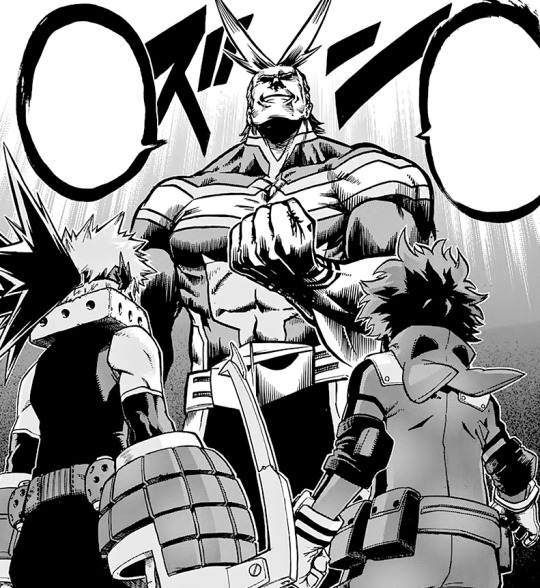
+I think the idea of the arc is pretty strong. Not only do we get to see more of the teachers in action, but it’s a cool watching the students go up against the worst opponents possible, with each one needing to overcome some kind of weakness in order to nab the win.
+The fight with Deku, Bakugou and All Might was good. It's their low point, with the two literally and metaphorically trying to overcome All Might, and only able to do so by learning from each other, effectively pushing the both of them forward in their own development together.
+The Momo, Shoto, and Aizawa fight was pretty good. While not as well established in the manga, I do like the confidence issues between the two and how it ties into their leadership abilities. Again, it's a good example of the two learning and growing from each other.
+The ending scene at the mall was well handled. It's such a great one eighty from the tone and really raises the tension. Then there's the set up with Izuku and Tomura's clashing ideals, ending with Tomura truly realizing his goal. All around good stuff.
-The structure of this arc is a mess. All the fights are happening simultaneously and there is constant cutting back and forth between them. This means that all the fights struggle to build up any momentum before quickly cutting away at the most jarring of times.
-On that note, the fights aren't that impressive barring the two I mentioned before. They don't really have anything to offer in either story or spectacle. It's a bunch of pretty basic fights where we are given focus to some of the blandest characters in the series. -While this arc is built around the students going against their worst opponents, there isn't a lot of interesting growth or dynamics. Of all the side characters, we got Mineta and Koda, who aren't that engaging to read about, nor are they developed in engaging ways.
-In spite of the greater focus on character and having tangible threat of loss, this still suffers from a lot of school arcs suffer from. An educational setting like this doesn't have much tension to it. All we really have are the fights, which aren't that good.
=Yeah, this is quite the rough patch between a lot of stellar arcs. I hoped that it was merely a victim of placement, and it had its good points, but that arc is such a mess that it's hard to get much out of it. Not the worst, but not one that I am eager to revisit.
MLA Arc: (4/10)
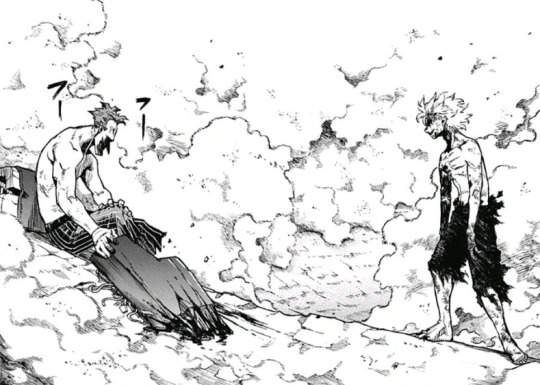
+The MLA is an interesting concept. A political cult wanting to give power back by letting people use their Quirks without oversight. There's a lot of interesting perspectives for that topic, both in and out of the MLA, for why people may or may not want this to happen.
+Tomura is easily the MVP of the arc. His speech to Garaki was good, but his backstory with the highlight. Seeing the sheer lengths that the world, his family, and All For One poisoned Tenko into this being of pure hatred was equal parts engaging and tragic.
+Toga's backstory was good as well. While I have my issues with how nebulous Quirk Therapy is, that ultimately doesn't detract from it. It sets up the ideas of love and it's the expression and repression that prevail in her character and their importance going forward.
+I like Re-Destro in this arc. He parallels Tomura as a rage-fueled heir to a criminal legend, but contrasts it by being someone who is totally in control of his feelings and power, as well as being successful as running the empire that was left behind by Destro.
-This arc introduces Awakenings. I have never liked this concept, even when it is first revealed. It felt more like a lazy way to give characters power ups when it was convenient. This was especially the case with Toga, even if it fits with her whole love theme.
-The MLA Executives aren't interesting villains. They're one note obstacles to the LOV. I get not every character will get focus, but you think the heads of this massive group of would be given some depth, especially with a basis of the MLA has so many angles to cover.
-The barely functional LOV somehow beating and taking over the biggest group of villains in the country is such a massive leap in threat and scale. For them to survive the fight, let alone totally dominate, feels like Hori needed to hand them the win for the story.
-Following that, this is where a lot of the rushed pacing. It seems as though that the story and characters are trying to rush the story as fast as possible to get it to the point where it needs to be rather than taking its time to make sure all of the steps are set up beforehand.
=I know this arc is a fandom darling, but I really don't care for a majority of it. For me, it's few strong moments to hold up this ultimately weak arc. Especially since it's where a lot of the flaws of the later half of My Hero Academia came to the forefront for me.
Battle Trial Arc: (5/10)

+The arc does a good job of establishing the weight of heroics in the world. While Aizawa laid the foundation, showing how the students failed in the trial in their own ways shows just how much pressure that goes into hero work. The recap of all the flaws and mishandling of the training exercise is really neat.
+This does a great job of showing off Izuku's value as a fighter and as a character. In spite of having the strongest Quirk around, his brain is his most valuable weapon, able to plan around somehow who vastly outclasses him. His vocal declaration of Deku being the name of the hero is such a simple yet powerful moment for him.
+In fact, that fight itself is super neat. Izuku has a limited ace in the hole, but Bakugou has a massive advantage in skill and a psychological edge. Meanwhile Uraraka has to deal with the villainous Iida. It makes for a fun dynamic in the fight on how everyone plays off each other in personality and powers.
+All the character establishment is well handled, something hard for any series. We get a solid mix up of the dynamic between Izuku and Bakugou, good understanding of Iida and Uraraka while having foundational moments for Shoto and Momo. Plus, Ojiro and Hagakure had a cute little moment in there as well.
-None of that is extended to any of the other characters. Again, with all of these characters together, it would have been a really good chance to establish more about them as an ensemble cast. Even if it was only in minor ways like the previous examples it would have helped a lot going forward and made them feel less like cut outs.
-By extension, we only got the one fight out of the arc. Look, I'm not asking Hori to make five extra chapters here. All I'm saying is that I think that it would have been a good chance to get a better showing of the characters’ abilities and personalities by having them fight and bounce off each other before moving forward.
-Look, I know I keep harping on the art, but its flaws become a lot more apparent when trying to do action scenes. It can make certain motions seem a lot more awkward than cool. Again, this may just be hindsight, but it was pretty distracting coming back to read this seeing how much the art hindered the experience.
-The structure of this arc is so bizarre in how it's laid out. The actual order of the panels seems like things are happening oddly or even out of order. Seriously, go back and read the lead up to Izuku confronting Bakugou at the end. It's janky as all get out. This is not helped by the pretty sloppy artwork with the characters.
=The first real fight of the series and it goes off with a bang. I do think this fight is a highlight of the early series, delivering powerful emotional moments and unique dynamic, both in combat and character. Though the series is still green and the early flaws of the series being the most prevalent here really holds it back.
PLF War Arc: (5/10)

+Izuku has some of his strongest character work here. Push to the brink, he regresses back to that totally destructive mindset and constant doubt of his early series version. And having the arc resolve with him having empathy for Tomura after everything he did is just great. No issue with how he was handled this time around.
In fact, I think a lot of the character stuff is pretty strong. Bakugou gets a nice moment by saving Izuku, Enji has to go through some of the harshest development when faced with Tomura and Dabi, and Uraraka is confronted with the most moral complexities of villains. And hey, the arc actually got me to like Miruko.
+The rest of the villains were solid as well. I really like the stuff with Hawks and Double. It works as a nice microcosm of a lot of the conflicts about heroes and the world's inability to understand villains and their issues. Toga's growth and confrontation Uraraka over understanding hero’s savings villains is all around good.
+The Dabi reveal was amazing. What was such a predictable plot point was turned into this amazing reveal, doing a total one eighty and Dabi's character for me. You take this melancholy loser and make it so he dances and reveals in all the suffering he is causing Endeavor. It's great to see it pay off in such a bombastic and impactful way.
-This arc continues the unfortunate trend of Tomura's power creep. His already insane level of power has skyrocketed without any sort of in between. And Tomura getting possesed is one of the dumbest things to happen in the story, robbing Tomura of all his character and agency in favor of someone else stealing his spotlight.
-Not everything is great on the heroes' side. Midnight's death is one a terribly handled aspect of the story, made even worse by Gran Torino somehow surviving and is the only notably causality on the hero's side. And while I get it's supposed to be Kirishima's moment, having Mina set up and undermine like that feels mean spirited.
-Some of the villains in this were let down. All of the relevant MLA members get off screened. I get they aren't the most important, but you think there could be someone more. Then there are the High Ends. You introduce a squad as dangerous as Hood, have them be an issue with one hero, and then kill them all. What was even the point?
-Aside from the Dabi reveal, all the other ones fall flat. Mr. Compress' backstory is here and gone. Oboro is a literal who that requires supplementary material to know who he even is. Mirio comes back with little fanfare and contributes next to nothing in his fight. And Best Jeanist's return raises so many questions, and not in a good way.
=I get this arc is super popular, but for me, it's one of extreme highs and extreme lows. When it's good, it's really good, but when it's bad, it's pretty awful. It's like for every positive, there's an equal negative in the same field. I ultimately believe that the good outweighs the bad, but not enough to make me rank it any higher.
USJ Arc (6/10)

+This arc goes zero to one hundred real quick and it's great. We go from low stakes practice to everything going wrong. The villains are attacking, the adults are out of commission, and All Might is nowhere around. It does a really good job of making this tension situation with real danger, making the pays off that more powerful.
+This is where we get more from the UA characters, doing a surprisingly good job of characterizing a lot of them in spite of having such a short time span, giving a lot of their characters their own moment to show off. Same with the teachers, with us getting more layers to the teachers, like Aizawa genuine care of the students.
+This is where a lot of Izuku's major character traits come about, really show off how much of natural leader he is and just he proficient he is in planning. What's more is the self-image and self-destructive issues come to light, such as giving up the president spot and when he tries to save All Might, adding a lot more to his own character.
+All Might is handled really well in this arc. Not only does it give us a deeper glimpse into his character, but just how he's handled thematically. It goes a good job of showing All Might's power with how he and how hopeless things are without him yet gives us a reminder that power is fading and is one a time limit.
+This may just be hindsight, but I like Tomura for this arc. He's the big bad but is almost constantly undermined and humiliated at every other turn, both physically and ideologically. It's a subversion that's hilarious in the moment but does set him up well for further development and helps parallel him with Izuku's own growth.
-Again, a lot of the early series flaws are present here. It legitimately feels like there are panels missing from the pages or that the panels are really awkwardly structured, such as a having a big moment in a tiny panel or panels not flowing well from one to another. It can make it a very jarring read and takes a lot from the experience.
-Man, for being the climatic fight of the arc, the actual battle with the Nomu and All Might feels super underwhelming. It may just be that the anime spoiled me, but it lacks a lot of impact a fight like this needs, the art doesn't convey the action, and is over pretty quickly. It makes the ending feel pretty flaccid, especially for the first big arc.
-While the main players of the villains’ side are cool, it does feel like a lot of minions leave some to be desired. Seriously, outside of Izuku's group, it doesn't feel like any of the students are under real threat from the horde of minions. It can make it seem like a lot of initial villains were pretty empty outside of the three heavy hitters.
=A big arc that finally expands the world and threats outside the school. Which it does a pretty fine job of. It's not exactly the same high of the anime, but it isn't too bad either. I think it works best when you see it as the punctuation to set up for the greater story. Now that it's done, we can start moving on to the real meat.
Endeavor Agency Arc: (6/10)

+I like the opening chapter about interviews. Besides the fact that most of the gags land and how I've really wanted to see the kids learn stuff like this, I really like the world building behind Super Moves. That they aren't just aces in the hole for a hero, they are a means of brand recognition that help solidify a hero's image.
+The Christmas part was just plain cute. I'm all for the characters doing non-plot stuff like this and I like a lot of the gags with it. All the different gifts people get, the background gag of Mina trying to dress Bakugou, and Eri getting all the holidays mixed up. It's a fun little break that doesn't mess up the plot or pacing too much.
+The family drama was well handled. I think it's interesting how Hori handled the family dynamics of the Todorokis. He gave each of the members their own perspective on a complicated situation, but doesn't invalidate any of them, nor does he try to quickly redeem Enji or say that any one of the family members needs to accept him.
+In fact, Enji is great this arc. Besides the small ways he is humanized on a more personal level and the natural dynamics he has with the characters, it does a great job by trying to separate the ideas of atonement and forgiveness in the arc and what the two really mean, something I believe is key to understanding Endeavor's story.
+The pacing of the arc is near perfect. Everything gets the attention it needs in the time it needs and nothing feels like wasted time or out of place. It goes a great job of setting up the next arc with Hawks' spying and Tomura's growth without detracting from the current plot.
-For an arc called the Endeavor Agency, there isn't a lot of time spent at the agency. The trio isn't learning about being heroes or having their characters really bounce off each other, whether it with their Quirks or overall personalities, skipping right to the end of it. It feels like a lot more could have been done with these three together.
-There are some worrying trends that come with this arc. Like how instead of getting anything with the agency, everything was frustratingly skipped over in a time jump. Then Izuku learns how to use "Black Whip" way too fast, mastering this wild power in a week. It contributes a lot to the rushed feelings of the later arcs.
-Ending is super lame. His design is middling, his power isn't that great, and his whole motivation is just worse Stain. I wouldn't harp on him as much if he were a bit villain, but Hori could have done more with him considering his importance to this arc. Heck, Starchild was more interesting and he's barely in this story.
=An arc that is often lost and forgotten by being sandwiched between two larger, series defining arcs. Which is a real shame because I think it offers quite a bit with all the drama doing on with the Todorokis and the levity of the early chapters. All around a pretty solid arc and does a lot to set up the next big arc well.
Entrance Exam Arc: (7/10)

+If I was rating solely on chapters, Chapter 1 would get a perfect ten. It does such a good job of setting up the world, the characters, the themes, the tone, and the conflicts in the amount of time it has. It's such an amazing foundation for everything going forward. It's honestly impressive all the leg work it does this early on.
+The exam is set up really well. Having there be Hero Points and the Level Zero robots was a smart way for Izuku to have his cake and eat it. He still gets to have his moment of heroic sacrifice, but it was that noble spirit was what got him that spot in the first place. Him finally getting in is such as powerful emotional moment as well.
+The whole reveal of "One For All" is such a good endpoint and hook for the series going forward. Izuku may have been gifted the greatest power in the world, but now has to deal with some of the most dangerous drawbacks in the whole series to limit it, still keeping the stakes giving him plenty of room to develop his power.
+The arc does emotional moments really well. All Might telling Izuku he can be a hero, Izuku triumphantly standing on top of the trash pile, to him rushing to the forefront to save Uraraka. Again, in spite such a limited amount of panel time, it makes each moment feel so much bigger and more impactful then it has any right to be.
+On that note, it does a great job of endearing and connecting you to characters. Izuku's position as an underdog is immediately sympathetic, as is All Might's unenviable role as the top hero. Which I think is a real achievement given how early we're into the manga and how hard it can be to establish characters in the beginning.
-As for the rest of it, most of it's just Izuku training and doing the exam. That's it. It's not terrible and it really goes to show Izuku's dedication to being a hero, but it's not something to really write home about. This could simply be that the first chapter was that good, but it's not as exciting going forward.
-Some of the early art is kind of rough. This could just be because I'm more used to the cleaner style of the later chapters, but it comes across as rather jagged for a lot of the characters. This doesn't feel like a intentional style choice, more of a series finding its footing and with the art style and designs needing refinement.
-This extends to the major players of this arc. Again, benefit of hindsight, but it they seem more like exaggerated versions of themselves. All Might comes across as a lot more callous, and even with the worst version of himself, Bakugou telling Izuku to jump off a roof seems really out of character for him.
=Ah, back in the days that My Hero Academia was the little manga that could. First impressions are equal parts important and difficult, so it really is an accomplishment that the arc is as well put together as it is. It all works as a great foundation for the story. With such a strong start, it's no surprise that it got pick up for more chapters.
Pro Hero Arc: (7/10)

+While the last few arcs did some leg work, the Pro Hero Arc did a lot of the heavy lifting when it comes to Enji's character. It takes this one note antagonist and actually makes him the underdog hero while still acknowledging all the bad stuff he did. It's honestly impressive how well this was pulled off given its starting point.
+The fight of Hood was great. Not only does it involve two of the most visually interesting and versatile fighters we've had thus far, giving a lot of ways to mix up the fight, but it manages to pull out some really strong emotional moments. This mixed with the pitch perfect pacing, and stellar art makes for an enjoyable experience.
+Hawks is such an enjoyable addition to the cast. Not only does he have an amazing design and power, but he’s also such a fun personality to hang around with. What seems like a total slacker, goofball is one of the most perceptive and skill heroes around. You're just interested in seeing what he does and how he bounces off Enji.
+And then it all gets flipped upside down by the end of the arc. Hawks was a kid raised to be a hero and is now going to infiltrate the League. Not only does this raise a lot of intrigue for the upcoming story, but it feels like such a massive upset from what we've seen of Hawks and the hero world as whole to have this happen.
+The out of battle stuff was nice as well. Besides Izuku getting his first fan in Kota, the fall out of the Todoroki's was well handled. In spite of his attempts at redemption, Enji's still hurt people and they aren't going to forgive him. It would have been so easy for quick forgiveness, but this makes Enji and Shoto's story all the stronger.
+The flash backs we got at the end with Izuku were pretty cool. It's interesting to see All For One in his younger years and how his empire camp to be. In the frightening world of Quirks with desperate people, his power to give and take power made him a king. It's a unique way to put him in power while still fitting within the world building.
-The other pro heroes have… neat designs. Look, for an arc that's supposed to be about the top heroes of Japan, there is shockingly little shown outside of Hawks and Endeavor. While they are the main characters, you couldn't have thrown a bone to the other characters? Maybe even revealed their Quirks or show off their personalities?
-Hood isn't that amazing of a villain. He's certainly a physical threat, but the fact that he's an intelligent Nomu doesn't really factor much into his character. He wants to fight, but that doesn't really give us much to work from. It feels like Enji is fighting some reflection or contrast and just something he needs to set on fire.
=Yeah, this was surprisingly good. The fact that Hori was able to turn around Enji’s to this degree is really impressive, but I do think that there is a lot more going on with the arc. It’s a good break from the main cast to flesh out the world and develops a lot of interesting ideas and plot points with the introduction of Hawks.
Culture Festival Arc: (8/10)

+Gentle and La Brava are great. They're so wonderful and different from everyone else. Their status as total jokes, both in and out of the series, betrays the fact that both are competent in their own ways and have a lot of care for one another. They're good set up for the later humanization of the villains of the series.
+I like the fight between Gentle and Izuku. Gentle's power is so cool to see in action and leads to an interesting fight dynamic. He isn't stronger than Izuku, but he's so tricky to deal with that it gives him an edge. It feels less like a brawl and more of the two trying to outfox each other, making it more distinct from other fights.
+This works as a good breather and much needed break from the more dower tone for the last few arcs, making for a comforting read. On that note, this is hands down the funniest arc in the whole series. Gentle and La Brava alone would qualify this arc for it, but a lot of the students have some good gags sprinkled throughout.
+I like a lot of the character bits we get. Not only does this arc actually develop Jiro and Eri, but it ties well into some of the general themes of the series. With how everyone is battered after the raid. It shows the kind of pressure that heroes go through and the importance of other kinds of heroics like Jiro's music.
+Not only does the arc establish the point of heroes saving people without fighting in Eri and Jiro's storyline, but the humanization of villains I mentioned before. La Brava and Gentle are both sad victims of circumstance who found strength outside the system in each other. It's affectively a microcosm of the major villains of the story.
-As much as I like this arc, I can admit it goes through kind of a whiplash plot and tone wise. Going from the Shie Hassaikai Arc to this is still pretty jarring to have everything stop and be light on both. I still like it, but I sometimes get the feeling of looking at my watch and wondering when things will be moving forward.
-There really should have been more exploration of the students. If you're going to do a plot light arc based around the school, it would have been a great time to see more of the students. If not from Class 1-B, who are major focuses of the next arc, then at least some of the lesser seen students could have had something going on.
=Probably one of my more controversial picks. I know this arc gets dogged on a lot by the fans, but I think that is wholly underserved. I thought it had a lot of value, even beyond its lighthearted story. And hey, I'm fine with taking breaks from the plot if I believe what's happening is worthwhile, and I certainly think it's worthwhile.
Sports Festival Arc: (8/10)

+In spite the low stakes of sport events, the arc manages to keep the tension up and mix things up with all the strategy and powers at play. Sure, running an obstacle course or doing a cavalry race isn't that cool on paper, but actively fighting against a horde of another students all with their own powers keeps it interesting.
+This arc really shows off some of Izuku's finest qualities. It was interesting seeing Izuku try and plan his way around the events given his huge disadvantages and amazingly shows off his character. Everything from his planning abilities, his skill in leading other people, and his genuine desire to save other people.
+Shoto was certainly the dark horse of the arc. While set up to be important early on, I don't think anyone could have predicted just how well his character and back story was done. That backstory really starts to delve into the darker themes of the story with his father, one of the top heroes, being an abuser that used his kids as tools.
+Of course, the Shoto vs Izuku fight is amazing. There is no contesting this. This is one of Izuku's most defining moments, effectively throwing away at chance at winning just to save Shoto. It ends in an emotional climax of Shoto regaining his power and Izuku losing, making for an subversion that makes sense and is satisfying. +The other side character work is done well, giving us more layers to them. Like hints of Iida's more vengeful side, Uraraka having this frightening amount of drive, and Bakugou showing some real respect to other people. It helps to subvert and expand on the characters, all while delving into more of their motivations and goals.
+This character work extends into more world building, especially with the new side characters. Shinso do a lot to build up the unfair the world can be in regard to Quirks while Mei introduces other aspects of the school and heroism as a whole. And this is all while they're both still fun characters to read about in their own ways.
-As for what happens in the rest of arc… it's pretty good. If you remove the highlight moments, most of the arc doesn't stand out as much in terms of what actually happens in it. I don't think it's bad by any means, but it's not something as amazing or exciting as the few highs of this arc and tends to skew a lot of people's perspectives.
-This extends to the other fights as well. Outside of the one standout I mentioned before, there isn't anything that spectacular to me brings up some frustrations like how Izuku was saved from Shinso by a Deus Ex Machina. Heck, the impetus of Momo's whole character arc is relegated to a single cartoonish panel summarizing the fight.
=I know this is a fandom darling and I feel a lot of that comes from the anime adaptation. To me, when looking at the manga, it's an arc of some extreme highs, but was above average to good with the rest of it. Certainly not my favorite but still a good arc.
Forest Training Camp Arc: (9/10)
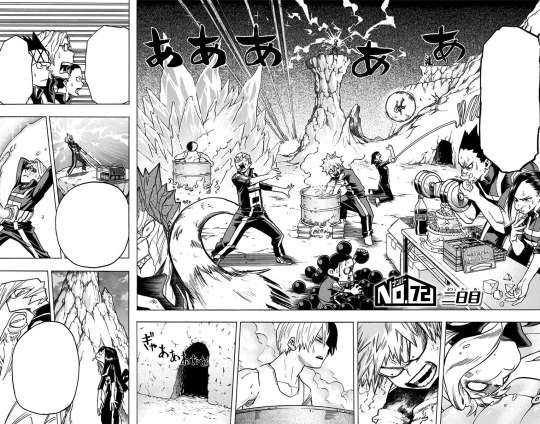
+As someone who really likes to explore the mechanics of Quirks and hero work, I enjoy the various ways these Quirks can be trained and evolved and what kind of roles and pressures they would have to handle. Sure, cooking isn't something we really think about with heroes, but it makes sense to know that for disaster work.
+It's really satisfying to see Tomura use all the lessons he's used thus far, putting aside his short-sighted schemes in favor of a more thought out goal with a plan to turn the narrative against the heroes and capturing Bakugou. That mix with the inherent threats of the villains makes the League seem like a serious contender.
+A lot of the villains are pretty good. They don't have a lot of depth right now, but they don't really need to for the purposes they serve. They are all established enough in their own ways that they are interesting to see and makes you want to know more about them, leaving things open for use to learn more about them later.
+I like a lot of the minor stuff we got with the students. A lot of the pre battle antics are good at fleshing them out, but they really start to shine in the second half of the arc. Whether it be as active players in the arc, like Tokoyami and Shoji, or setting up for their own stories, like with Uraraka and Aoyama, it's all good stuff to read.
+Izuku vs Muscular fight is great. There's some real tension with Kota being threatened, we see Izuku being more emotionally and physically broken than any other point in the series. Only for him to overcome it with one of the most emotional panels in the series. The Million Percent Smash being such a perfect punctuation with the whole battle.
+I appreciate the arc ending on such a dower note. In spite everyone's efforts, the villains won. They kidnaped Bakugou, a huge portion of the students are in critical condition, and there is a potential mole within the walls of UA. It works as an affective low point for the next arc to build off of for the story.
+And in spite of the dark tone, the arc still manages to be really funny, like all the small interactions between characters, like Shoto subtlety throwing shade at Bakugou. And I standby that Izuku suddenly getting punched in the nuts is still one of the funniest moments in the entire series. I will die on this hill.
+This arc hits a perfect balance of pacing. The first half of the story is full of fun antics and lighter moments between the characters while the latter half is full of highly emotional action with a new gallery of rogues. And when it hits the ground, it hits hard and fast, never letting up on the fights and intrigue with the characters.
=While not as groundbreaking as some of the higher ups, I still hold this arc in a special place. Everything from the characters, to the fights, to the emotional beats are all handled so well that I often consider it the best of arc of the series. Even if you twist my arm, the only fault it has is that I simply like the other arcs more than it.
Stain Arc: (9/10)
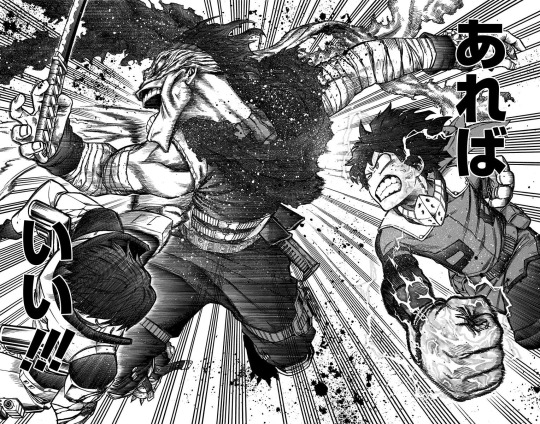
+The art style drastically improves this arc. While I certainly saw a leap in quality once we got to the Sports Festival, the manga really starts to hit its stride once we reach Stain. The characters have more detail to them, the backgrounds pop a lot more, and the paneling is handled a lot better, making for a stronger experience.
+I like a lot of stuff with hero names and internships. Agian, it's a quick and easy way to help us understand and endear ourselves to the character while still developing the bigger ones, such as Iida's uncertainty as a hero after his brother’s injury or Bakugou trying to learn more about the social nuances of being a hero.
+The Full Cowl was such a good idea. The bone breaking was a neat gimmick to start with, but ultimately unsustainable concept. This offers a good side grade that still fits within the power. It gives Izuku far less power but grants him more control and a way to measure his progress throughout the series.
+Tomura and Izuku get some much-needed development. This arc sees them both growing beyond their world view when faced with an outside force, with Stain acting as their reality check. It sets up how the two will grow opposites throughout the series and further reinforcing the two parallels of our two main leads.
+Shoto and Iida get some time to break out of their original shells. While it's nice to see Shoto being far less cold to people, Iida going on a revenge quest is such a drastic yet believable turn for him. Having his righteous vengeance turn on its head and how such a thing would only sully the family name is all great stuff to read.
+Stain is such a great villain. He commands every single scene he's in and always remains a real threat in spite of his lackluster ability. Though the real meat is how much he's able to challenge the world and characters we see. The man has an iron clad code, one that makes he ready to lift up or deconstruct anyone he comes across.
+The fight with Stain is great. Stain is outgunned and outnumbered, but never outmatched, having much greater skill and what amounts to a one hit KO. That mixed with the closed off arena gives him a massive advantage. It's such a uniquely balanced fight and leads to a lot of interesting back and forth, yet still makes Stain a real threat.
+It feels like there were some real consequences to this arc. Stain wasn't some one-off villain, he changed everything, inspiring more villains and building up for the next big arc. Then there are hints to All For One, the who harmed All Might, being behind everything. It builds up a lot of intrigue for the rest of the story.
=Yeah, there is a good reason everyone talks about this arc. While Stain is the standout figure of this part, I do think it does a disservice to the rest of the arc to only bring up him. It's able to balance so much so well with how each of the characters grow and all meet up in fight. So yeah, it's well worth all the hype it gets.
Hideout Raid Arc: (10/10)
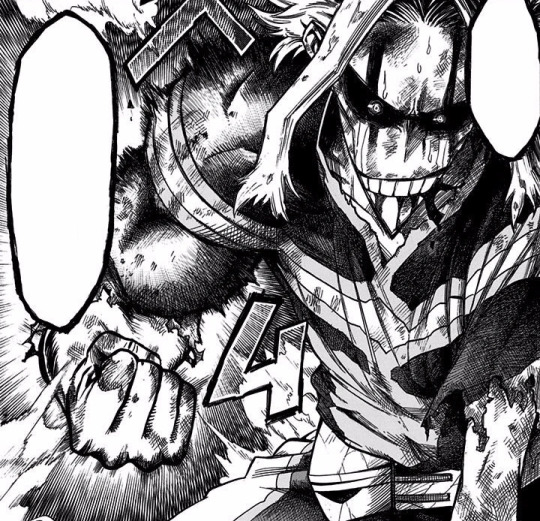
+This handles a lot of the aftermath of Forest Camp Arc well. All the students emotionally handling things and the teachers dealing with the fallout being well done. Giving Izuku a very real threat of damage to his body if he keeps pushing himself too far, set up some real stakes for his training and any future battles he has.
+I like a lot of minor moments between the students. Things like the debate at the beginning of whether or not to save Bakugou helps flesh out the class a lot. Then the bit of Momo and Iida keeping their friends from rushing in are good moments for them while still establishing just how big of a threat All For One is.
+And this is the arc where I think Bakugou clicked for me. We got hints of his depth before, but this is where it comes together. It gives us such an interesting peek into his headspace, like the view we got of his home life and getting his perspective on the concept of heroism and how it ties into winning for him.
+All For One's reveal was handled so well. The shadowy man we've heard so much about comes out with a devastating attack, destroying any opposition and horrifying the nearby students. It's nothing truly groundbreaking, but It's all presented so well that it elevates so much in the eyes of the reader as an impossible threat.
+The All For One vs All Might fight is one of the highest, if not the highest peaks in the series. What else could I possibly say? The beats are simple, but the execution is nigh perfect. The back and forth of the two, the reveal of Small Might, the second wind of power, All Might learning from Izuku, and the United States of Smash. All amazing.
+And while many people remember the main fight, I think the aftermath is just as good. The conflict between Izuku, Inko, and Toshinori is so natural and gripping, with Inko wanting to protect Izuku in spite of his dreams and this in turn hardening's Toshinori to the resolve of his new mission of training Izuku.
+Said aftermath sets up some many interesting and exciting plot points. The fall out of All For One's capture, All Might needing to deal with his life after being a hero, Izuku having to bear the weight of "One For All", Bakugou feeling guilt over All Might losing his spot, and the still immature Tomura now being out on his own.
+The tone is really well handled here. It gets pretty grim, but it doesn't get so dark that it takes you out of the experience and hits all the hopeful moments just right. And again, the comedy is oddly strong here. All Might opening his big entrance with a pizza delivery line and the rescue gang trying clothes on in a thrift store.
=Now, I don't need to tell you why this is good. What you may be asking is why it's not at the top. While I do think that All Might vs All For One is amazing and a good chunk of the arc, but there's still the rest of it. Again, it's some good stuff that gets overshadow a lot, but it's another case of something so amazing elevating the rest of the arc.
Shie Hassaikai Arc: (10/10)
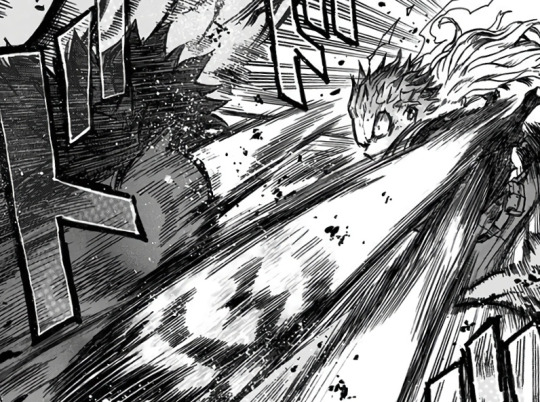
+Not only is this arc unique from all the other arcs thus far, giving us our first real look at the hero world, the arc is great technically as well. It's always keeping up my interest and doesn't drag on at any point. The art is really good, especially with the character designs. Everything is as long as it needs to be, and nothing feels awkward.
+I really like how Izuku is handled here. He has been defined by his self-image issues but tackling that as All Might's successor is interesting. It does everything in its power to make you question if he was worthy, yet is always showing you his merits, namely his relentless will to help people no matter the threat may be.
+Sir Nighteye and Mirio are both good characters as well. They do work to contrast's Izuku own feelings and his role but are still enjoyable characters in their own right. Mirio as a hard-working hero with a good heart and Sir Nighteye as a fatalistic naysayer are both great in their own ways.
+In fact, a lot of the side characters are good in it. Kirishima gets a lot of good development, Tamaki is fun to read as the shy dork he is, Rock Lock presents a unique perspective on hero students, and Fat Gum is Fat Gum. Even with the more minor characters, they stand out enough to be interesting in spite of their lack of panel time.
+To me, this is the arc where Tomura really hits his stride as a villain. Without any proper support, he grows into the leader needs to be the League. Not only does this lead to some of his best moments and sets up his story but adds some much needed layers to the burgeoning villain, showing some real care for his teammates.
+Overhaul is such a great villain. Not only is he a massive threat in power, resources, and overall abilities, he acts as a good foil not only to Izuku, but to Tomura as well while still being his own character. His plan and goal are so unique for the setting, yet offer a frightening endgame, effectively controlling the supply and demand of Quirks.
+By extension, I think this does a lot to characterize the rest of the villains. Obviously, Twice and Toga get the bulk of it, building them up as people beyond their gimmicks, but the rest of the League gets their own moments to shine. This extends to the yakuza minions, who I think are my favorite ensemble of villains in the series.
+This arc ends on such a great note. Sir Nighteye's death crushes the heroes' side in spite the reconciliation. Meanwhile, Tomura gets out like champ, getting revenge on Overhaul and leaving with a dangerous weapon in his hands. It's a good way to start the slow shift of the dynamic between heroes and villains going forward.
=So while this doesn't think this hits the same highs as the Hideout Raid, I think it does accomplish more with its scope. It has a lot more to juggle in comparison to the Hideout Raid and pulls it off with flying colors. It obviously doesn't hit the same peaks, but holds as consistently level of quality, making me prefer it.
#My Hero Academia#Not Quirks#Midoriya Izuku#Deku#Katsuki Bakugou#Shoto Todoroki#Tenya Iida#Ochako Uraraka#Uraravity#All For One#Tomura Shigaraki#Dabi#Himiko Toga#Jin Bubaigawara#Twice#Toshinori Yagi#All Might#Shota Aizawa#Eraserhead#Enji Todoroki#Endeavor#Keigo Tamaki#Hawks#Chizome Akaguro#Stain#Overhaul#Kai Chisaki#MHA Meta#MHA Theory
61 notes
·
View notes
Text
EVERYONE NEED TO READ RADIANT NOW!!!
doing Radiant propaganda but seriously. seriously read it. it's my favorite series and I have been following it since it came out, it got a huge succes in Japan, but then the hype died after the anime got out and it makes me so sad, because it's seriously amazing and I believe the Tumblr population would love it oh and, yea, I did say, READ! I would... heavily not recommand to check the anime. I haven't finished the first season because of just how bad it was. it's like, they tried to turn it into regular One Piece inspired shonen, the animation is quite terrible and in the span of 10 episodes, there is like half that are useless and complete fillers?? on the FIRST season??? bad. really bad.
I will now proceed to explain YOU, WHY you should read Radiant NOW
I'll start with explaining what is it about; Radiant is a manfra (french manga) created and illustrated by Tony Valente, and (apparently) the first french manga to get published in Japan, where it got a huge success the story takes place in a fantasy world that casually gets attacked by eggs falling from the sky, and that hatch into monsters called Nemesis. these monsters are able to use Fantasia, a magical source, and are devastating; as a matter of fact, any human entering in contact with them will instantly die, EXCEPT for a very small proportion. those who survived the contact will become "infected", which mean they will receive an unusal feature (this one can be visible, like a tail, or not visible, like mood swings), and will be able to manipulate Fantasia themselves, making them the only humans able to fight against the Nemesis. these people are called witches however, even if they are life saviors, witches are often badly seen, because they are as dangerous as the Nemesis themselves, and many rumors and beliefs are around them (that they made a pact with the Nemesis, that they are Nemesis themselves, etc...). as a result was founded the Inquisition, a mercenary group specialized in hunting down the witches, and fighting against Nemesis without the help of witches the main character of the story is Seth, a young witch who, after hearing about the Radiant, a theory about the existence of a "birthplace" for all Nemesis, wishes to destroy it
NOW it looks pretty common, and that's quite fair. the story takes a lot of inspiration from popular shonens, as well as the Arturian myth, with a lot of references to real life witch hunts. but there is many things that make it very special, and to start with its messages and the symbolism behind it. if you look at it, Radiant is a lot about the freedom of speech, and the expression of art. Fantasia is a magic system that relies a lot on the user's imagination and self expression, and the Inquisition is trying to limiting its use, pretty much like censoring. there is also a huge message against racism and discrimation as a whole, with the fight for freedom and acceptance of difference, but also with grey sides on both parts; whereas the Inquisition is discriminating witches and showing them as monsters, some witch groups will react violently to it, and start riots, attacking innocent civilians, and tun into the monsters the Inquisition was showing them as. the most important message of the entire series is humanity, and to learn how to "be" a human, with a lot of other messages
and it does it VERY WELL! dont get fooled by how slow the plot may be at the very first book, it quickly becomes something amazing on the first arc. every character is deeply attaching and human, they all have strengths and flaws, and their own story. it's also probably good to say that for a series with a message on differences, there is a lot of representations of all sorts, we have a lot of feminine characters with important roles, characters with skin of color, disabled characters, lgbtq characters... and it's hardly forced as if to fill an agenda. like for exemple, there is a blind character at some point, but characters dont point it out like "oh hey, are you blind?", and the character is not shown as being a weak, poor little thing. you understand it simply by seeing the character and how they act, and it's just clear, its smooth, and its normalized, and I find it amazing how it's represented
as well, the ART STYLE. Tony Valente started working alone, and now gradually got assistants to help him, but he's still doing a huge, HUGE part of the job, and makes it worth it to wait ~5 months between each book. the characters have really nice designs, there's a lot of variety in the shapes and body types, and some pages just made me sit down for a bit and go "wow". the series has been going on since 2013 (there is currently 18 books so far), and you can see Tony's improvement through it. I mean, look at THESE

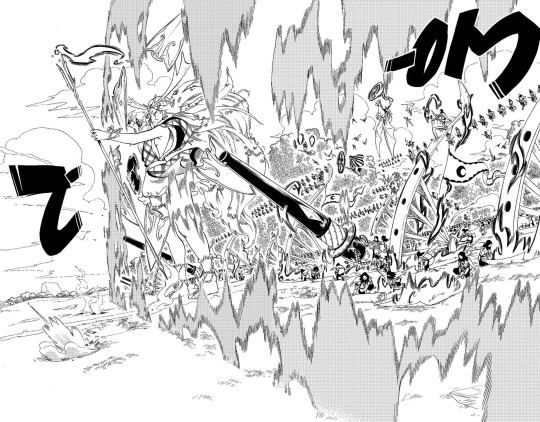
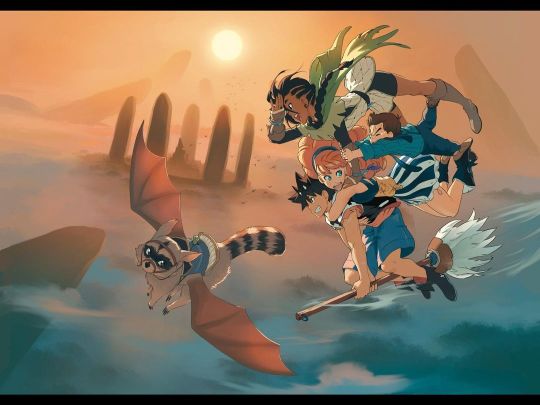
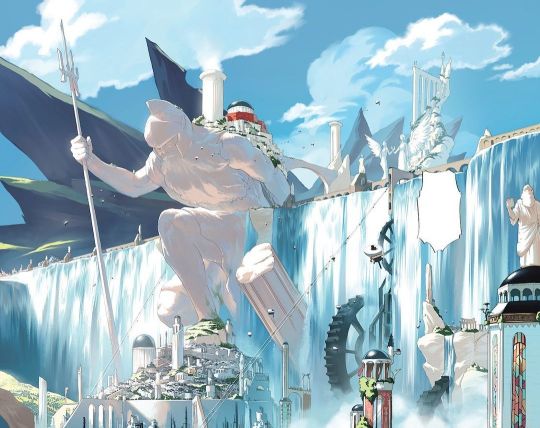
I seriously cant stress it enough how much I lobe this series and how much I enjoy rereading it every so often, so really really, I recommand it vividly, and i want it to EXPLODE, i want maximum support and love for this series and the author!! i was reading it when i was 12, i still am reading it, and its very dear to my heart, even if i dont get to show it often because there's hardly any community around it,, so really, CHECK IT NOW
#i am going insane#i dont know how to tag it just know im insane#manga#manga recommendation#radiant#??#whatever
7 notes
·
View notes
Note
Hi
I got curious how you ranked the legitimacy of information by the form of media it is presented. (Ex data book>manga>anime>anime filler> novels)
Thank you for sharing your insight
Hello 👋 thanks for the ask

1- The first and most legitimate source is ofc the manga, it is the original source of the entire story that Kishimoto created himself from the beginning to the end so it's the most canon canon of all canons 😂
2- The official Databooks/Fanbooks because they were all written by Kishimoto as well, even the ones that are called fanbooks, unlike some fans seem to think, they were actually written by Kishimoto for the fans not by the fans, answering the fans requests and questions and this is why they are called fanbooks.
3- the official light novels because Kishimoto heavily contributed and has written the basic outlines of the story and what he wants the characters to do and be like and his editors only followed those instructions and none of it was published without kishimoto's review and approval, like I explained here
4- aside from Naruto The Last Movie which is written by Kishimoto so it's canon as well, I don't consider any of the other movies and anime fillers as canon at all, they are just there to get more money for them to be able to have a better budget for the anime and also to give the Mangaka enough time to write/draw the manga... But anyway, I don't mind them and they are fun to watch and enjoy as long as they don't contradict with canon, but once they do, the canon fact completely cancels them. Some fillers are more legit than the others tho, like Kakashi's Anbu arc which according to the databook was originally Kishimoto's idea and was written based on the original idea that Kishimoto came up with.
5- Rock Lee and his Ninja Pals, even tho this show is in no way created to be taken seriously whatsoever and is literally a parody show, I'm including it here because I see a lot of ppl referring to things that happened in it as a canon reference, which is completely ridiculous lol, the show wasn't written by Kishimoto or even any of his editors and was made just literally just as a joke.
52 notes
·
View notes
Text

@traditionalartist
Kouki is living a normal slice-of-life story. He wakes up everyday to go to work, he greets the neighbors, he smiles at the customers, he calms them down, and he goes home and reads his manga. One particular manga, a work he has been following since high school, is about a hero who will stop at nothing to defeat the villain of the arc. It has been 23 story arcs, the hero is still fighting, unwavering, handsome, and devastatingly without a love interest.
One day while going home from work after fighting with a rude customer that got him fired, he was pushed by someone towards the road and met the fate delivered by truck-kun. He woke up in the hero's world, and surprisingly enough, the hero, Oreshi, knows him as one of his beloved characters from a book he adores. He's had crush with the main character for the longest time.
"Me??? Why would you like a character like me? And why would you read a book about my boring life???"
"I love your simple adventures and your genuine heart. If everyone in this world is like you, I wouldn't have to be an exhausted hero."
"You're exhausted? I thought... you fight non-stop for world peace?"
"You have no idea how much I want to live in your world. With you."
Kouki feels for him. By arc 17, Kouki realized how Oreshi's story never had any omake or filler chapter where he lounges around with friends. He's always fighting, and if not, he's alone.
Fuck it. Kouki said to himself. This is just a fictional story anyway. I'm taking Oreshi away from here.
And so the two ran away to the faraway forest and lived in domestic bliss for months. They made a house and lived on farming and trading. The world wondered where their hero was, but for once, Oreshi was happy and contented. He doesn't want these moments to end.
One day, there appeared a mysterious and unknown man. He is fast. He is strong. He is cunning. And he looks exactly like Oreshi. He is the villain of the 24th arc.
He defeated Oreshi easily.
"Just so you know, I planted this average and mediocre boy in this world to serve as your weakness." The villain laughed. "How does it feel to finally lose, and in the hands of a powerless at that?"
"You..." Oreshi seethed towards Kouki, "The two of you planned this???"
"That's not true!" Kouki cried. "I never intended to do that. I just wanted you to stop fighting!"
The villain inserted, "And that rendered him unprepared and without training for months. My, my, I never pegged you to be so useful, you useless commoner." He looked at Oreshi, "Now that my job here is done, I will take the final blow and take this boy you loved so much, since you hate him now."
At the villain's lair, Kouki becomes a prisoner the villain, Bokushi, pokes from time to time. The villain loves teasing him with hurtful words that involves Oreshi, and how he has become his devastating weakness.
Kouki's heart grew darker, his hatred towards Bokushi turned him to think, fine, I will be your weakness as well. And then Oreshi can defeat you
Kouki learned how to use his charms.
And it worked!
Bokushi fell hard.
And he became the villain's weakness.
Oh, and Oreshi is marching towards the villain's lair, ready for revenge against Kouki and Bokushi.
He expected that they would be buddies, Kouki played with him for Bokushi after all, but he never expected the sharp pain upon seeing their bodies intertwined.
#akafuri#furihata kouki#knb#akashi seijuurou#kuroko no basket#this is too long#but I love stories about angst and betrayal#this is fun
10 notes
·
View notes
Text
i’m not a fan of usagi/mamoru but i’ll still take it over whatever the hell rei/mamoru was supposed to be any day bc never have i felt more like the writers and the characters involved all had a gun to their head forcing them to make a relationship happen against their will
i’m pretty sure it wasn’t a thing in the manga iirc so i’m genuinely wondering if it was only added to be filler or due to executive meddling bc there’s no way they seriously expect me to give a single shit about it when they had them get together and break up off-screen 💀
their entire ““romance”” is literally just her asking him out bc he’s a man who exists and him going “eh…. i guess 🤷♀️” followed by a few painfully awkward interactions where he does not listen to a word she says or even answer the phone when she calls to arrange a date
and when rei finds out usagi and mamoru are destined to be together she instantly accepts it without seeming the slightest bit upset?? don’t get me wrong i appreciate the lack of melodrama but what was the point of even introducing that sorry attempt at a love triangle then 😭
28 notes
·
View notes
Text
the deen higurashi animes are not that bad people just watched them when they were 11, heard people say they were bad, then read the vns much later and went "well its not exactly 1:1 so it really is bad"
you really have to appreciate the work chiaki kon did to make the original higurashi anime coherent in 26 episodes. sure its not perfect, but compared to most vn adaptations, are you kidding? deen higurashi is perfectly watchable. it's no clannad but i consider it a successful vn anime adaptation that stands in a field of failed vn anime adaptations. it is great as long as you stop after finishing kai and do not touch anything that came after it
also this is only tangentially related but since i see people sometimes lying that ryukishi may not approve of this, or especially of the umineko anime. not true! the umineko anime is a different matter because the production of that anime was a mess, the story was releasing AS THE ANIME WAS AIRING, and ep4 was horribly adapted by virtue of it literally COMING OUT LITERALLY AS THE ANIME WAS AIRING. ngl though, as much of a mess it was, it was one of the first anime i genuinely followed from the first episode to the last as it was airing. and what an anime it was. absolute trainwreck, everyone was happy that EP3 was actually adapted pretty well after how goofy EP1 was and okay but derpy EP2 got sometimes, then came EP4 and uh. haha.
but i digress... my point with this^ is that a lot of people have delusions of grandeur of original authors hating an anime adaptation just to justify their own hatred of it. i see it all the time, especially with old adaptations of shounen manga superseded by either remakes or sequels (rare, but i'm thinking of bleach here). people have this long standing urban myth that togashi HATES hunter x hunter 99, but the only recorded opinion we've ever gotten of it is that his assistants would watch it while he worked away on the manga itself, so he didn't have an opinion on it. a lack of an opinion does not signify an opinion. if anything, there are more clues pointing to togashi being involved in the anime in at least some capacity— namely the bonus stage arc, which has foreshadowing for things that hadn't even happened in the manga yet at the time, and was allegedly based on scrapped drafts that togashi had.
really, lately "mangaka is involved with every step of the adaptation" has become synonymous with quality, but manga artists are manga artists. not all of them know what decision is right for the animated medium. i have yet to see an anime turn out especially good because the studio kept the mangaka in the room making whatever level of decision they can claim happened. (to be honest, i kind of doubt it anyway, but i don't care.) it's dumb, but i miss the era when adaptations were actually about adapting to a new medium and having *shudders* oh noooo spooooky filler to help the story flow better, or hell just diving deeper into certain scenes and expanding on them, rather than having a big jack off contest about who can draw the closest to the manga without any deviation so a bunch of salivating geeks on twitter would tweet at any public figure involved in the anime with either praise or insults both 100% lacking in any critical merit
at least.... can we stop animating at 300 gigasharts per second to appeal to twitter shounen meatheads so we can get anime longer than 13 episodes again. im fucking sick
#got higurashi on the mind this week#rambles#people will eat up sotsugou and then say the 2006 anime is bad#fuck outta here#long post
10 notes
·
View notes
Text
Political System of Konohagakure and Naruto’s world as a whole
Functionally the Naruto setting is one that is dressed in a fashion that’s meant to resemble Edo Japanese government, but it (visibly) misses the top 3 levels of its traditional hierarchy, notably: The Emperor, Court Nobility, and Shogun.
Ultimately this means that the feudal society in Naruto is not 1:1 inherently with Japan’s, because of one remarkable missing point that either has not been touched on (unlikely) or simply doesn’t exist (more likely). The Emperor and his court simply do not seem to exist, there is never remark of a greater political power than the Daimyo, excepting the Kage who seem to be able to act independent of their “benefactors” in the feudal lords.
So the following solutions are what is likely the reality of Naruto: -No centralized government exists, the Daimyo is simply a familiar term applied in an unfamiliar way, more like how a king would operate, with each of them vying for their own political gains and strength, with smaller countries being run by a chieftain. OVAs somewhat indicate the chieftain thing to be true of Takigakure, where the village is small but the country also seems vaguely similar to this, but we have no external information about how the host land of that village formats. This is also contradicted by (filler) Land of Fangs and Claws being relatively minor powers that still have their own Daimyo.
-Loose centralized government that is in shambles. In this case Daimyo functionally occupied their original function, but spent a time in the warring states period as functional shogun too (though not quite they were simply their own military leaders since these countries had to hire independent forces of mercenaries to have any military strength). The warring states period implies that this is the case, and that whatever government preceded it fell. There is a possible origin point in Kaguya as the head of this government as a sort of tyrant, but creating a complex system of nobility seemed of little interest to her, in manga and anime alike. Most likely this loose government existed for a length of time, but fell to hell before the warring states period, possibly only a couple of generations before Hashirama’s.
-The above loose centralized model, but it is simply a dead system that no longer exists. This has all of the same dressings as the previous example, but without any sort of context that daimyo are expected to operate under. It makes sense as the states under them are referred to by “Land of” monikers.
-No centralized government exists, what the Naruto world has developed into was the first form of government to become widely adopted. A group of companies with a vague cultural association eventually forming into non-militaristic states simply seems unlikely, especially with more potentially strong bandit bands (later shinobi ones) exist and form either alongside or later and simply do not take control of it.
Personally I’m operating under a loose government format, though whether it’s still instituted somewhat (my bias) or not is of little consequence as a ghost government that can’t control the various kings means little.
So with that in-mind, I think the broader Naruto world’s government works like this:
Central Nation, tentatively referred to as 曦大国 (Kitaikoku) or “The Sun Nation”/Sun Country, is an imperial nation that at one point contained the entire Naruto world’s map, and likely some unconnected territories that are no longer communicated with. The Sun Country functioned with a system that delegated control over moderate-territories of a similar size to various distant relatives and associations of the emperors’ from court. These various fiefdoms or “Lands” are essentially under the emperor’s control, though with little care for the day-to-day management of the various territories is of little interest to the larger country. The Sun Country’s government was initially composed of samurai (non-lineage-based variant consistent with Naruto), lead by shogun, though at the time the shogun system was more akin to a military officership who were given legal authority, rather than de facto.
During the period of the Sun Country (we’ll call it The Sun Period) the structure is like this:
Emperor (Monarchal) A political authority that arbitrates policy and ultimately operates as the government’s head, delegating authority of rulership among the daimyo and military matters among the shogun. | \ Daimyo - \ | \ Court Nob. \ | Shogun Classical Peasantry | Artisans | Merchants | Untouchables
Although the court nobility in the original Japanese system was placed on a higher keel, their relevance in this system is reduced because as opposed to the country’s emperor, they still have little political power, while the reality of the Daimyo is that they are members of the imperial noble family, or otherwise are bestowed with prestige. It really shouldn’t be caught up on their relative importance as they’re both above the shogun, and if you feel like those who share space with the emperor should still be seen as superior despite having a lesser function that’s perfectly fine because in either case Court Nobility basically had no place upon entering the Warring States period.
As-implied through Naruto, samurai predated shinobi, and the clans of samurai that eventually become shinobi ones pretty much becomes a transition, though the Sun Country had no official accounting for shinobi due to the circumstances that caused the Warring States Period. Samurai in this system were able to be given power by Daimyo, but a Daimyo’s samurai were limited in authority to their feifdom.
Sub-Samurai society doesn’t have much cause to be changed, particularly since a caste system in Naruto doesn’t seem particularly observed (although that might be a limitation of Naruto’s perspective existing in a mercenary city-state within a larger country).
The Sun Country likely had to exist for a few hundred years in order to reach its border size and authority as implied by the current Naruto map, but the period of reign likely was longer especially if the samurai stuff is linked to it. But when the advent of shinobi came along the military system that previously relied on chakra-enhanced samurai was utterly upended, so weaponized ninshuu was clearly a game changer.
With the shinobi coming in, with more assassination-based tactics that are otherwise unstoppable, it’s only a matter of time until a play is made for the emperor-ship. As the emperor and his line is killed the country descends into a state of chaos and war, due to the daimyo having various degrees of relation to the imperial family or other more meritocratic claims from some.
The samurai clans steadily begin changing over to shinobi and ninjutsu, we see a struggle between the shinobi clans for military and financial relevance, and though fiefdoms do have associated shinobi/samurai clans the majority of the might is independent and requires financial investment. This period of a feudal era without a shogunate proves its problem, which leads into the Warrior States Period, and eventually the establishment of shinobi villages.
The modern system of government in the shinobi world, regardless if Sun Country is even an acknowledged thing anymore or not, more or less centers on this weird cannibalistic relationship between daimyo and ninja village. While the majority of people pretty much are concerned with the dictates and laws of their feudal lord, the actual power in a de facto sense does, in fact, lie with the military might of the Kage. So, we could just have a gander at pretty much the weird situation as it follows:
Daimyo (Thinks themselves at the top and finances their shiobi village) ^ ^ | | x | | v v Kage (Actual military power, not sole, financed by the daimyo but seems to not act within their purview mostly, but also seems selected?)
The process for selection of Kage seems inconsistent, sometimes it seems that a predecessor names the successor, the first was democratic (which made sense since he’d be the one leading the band to pitch to the daimyo) but then following an assumption of Tsunade’s death or inability to retain office it seemed that the feudal lord actually exercised a bit of authority and declared Danzo. The lord also seemed familiar enough with the happenings to know who Minato is, and trace a lineage of “power”. This system likely varied between regions, though, as beyond establishing the village there was no responsibility that Hashirama seemed to hand down to the future kage except to make sure they formed the Shinobi Village system in the strongest nations of the era.
Generally, though, it seems that daimyo serve a similar position to the actual feudal system of being political and financial endorsers of their favored shogun (in this case Kage) while the actual kage seems to operate differently based on the village’s own systems. Overall, however, it seems that each kage is essentially a type of military junta. Some could argue that a kage is more akin to a chieftain, and the implied public perception (normal people do not care for shinobi particularly) is that daimyo are placed above shinobi, but it seems that in most cases it’s unlikely that any individual country could probably withstand a coup from the village itself. This is why Zabuza was such a threat, as he attempted to launch such a coup, but failed to get the backing of his village, but it is clearly a real threat.
Of course, if there was still a loose confederacy that was formed as a result of the shinobi system, it’s clearly one without a leader, as warring nations don’t seem to fuck with The Land of Iron; a policy which I don’t think so many countries would simply stick to out of clearer heads.
The daimyo seems to operate (in the land of fire) at the advisement of a council, like the hokage, but it comes down to ultimate arbitration. It’s likely that he only factor in public opinion based on a sense of self-preservation, rather than actually caring. His indifference to who was the most educated in the room, but rather who spoke the loudest shows that the daimyo are rather arbitrary rulers to begin with. So their true value is almost definitely in their wallet and at one point a legal authority and dominion over land that allowed them to tax citizens.
In lieu of a real samurai class, it is likely that daimyo is still a position passed through a family line, as the original claim of relevance largely had to do with a relationship to the original emperor, striking down a daimyo probably causes more harm to the nations that they lead than they might have in real history. And kage, though it seems that sometimes there is a preference for a legacy linking to the original leader of the village, don’t have any requisite for association.
Now that the infodump around the broader political situation, let’s take a look at konoha specifically in the next post.
14 notes
·
View notes
Note
not really what the ask meme was about but i'll bite. what do you think about boruto (the series)? i'll say i will save sarada and chouchou from that series and move them somewhere else
the thing about boruto is that all the issues i have with it started in naruto. like by far my biggest issue is that i find the alien stuff too silly to take it seriously, and that started with kaguya, so boruto was already set up for failure in my eyes.
i have said it before but for me the ideal ending for naruto was a world without ninjas, a complete dismantling of the ninja system, so boruto not only having to follow on the stupid alien concept introduced in the war arc, but also being set on a basically unchanged world, is already not going to be a compelling story for me. my favorite part of naruto was when the characters confronted the gritty and dark and morally gray aspects of their world, but all this has been left behind in boruto. boruto is not concerned with the faults of ninja society, because we are led to believe that despite nothing fundamentally changing about the world, theres no longer any war or hatred between the ninjas, the entire conflict (from what i have gathered) is just alien bullshit. every time i look at a screenshot from boruto it looks too sanitized, too clean and soft. not to sound like an old person but. In MY chunin exams people were killing each other. to me boruto feels like the entire thing is one long naruto filler arc. and also it looks kinda ugly. the character design is shit. the manga artstyle is awful, i think its an insane downgrade from kishimotos style. boruto the character is so annoying to me. the way naruto and sasuke are written is so out of character, why is naruto such a shitty dad and why would sasuke, whose entire story is about how much he loves his family, be a dead beat dad??? And i dont even want to get into how the women were nerfed.
i DO like sarada, and chouchous design is really cool, i think having sarada as a main character might have made the story somewhat better, but the entire set up of boruto is too dumb for me
5 notes
·
View notes
Text
I understand why people blame gege, but without the AUTHOR there would be no character or complexity. Do fans forget that a character is a part of the author’s mind? You can’t say that last part of the tweet, it’s absurd.
And the why their discomfort it’s understandable is because as a consumer you were sold a certain image of a story/character because they were interesting in the beginning, and you are left dissatisfied with the final result because that’s not even remotely close to what was told to begin with (with subplots, interactions, or the way an author creates a path for the readers that keeps interest while being solid on execution). Yet, after so many years, specially story tellers, in any kind of media they prefer (books, manga, comics, etc), you may gradually loose interest and love in your own project and be half done with it. I have experienced it; revisiting drafts, or ongoing fics, or personal stories and you just want to scrap a big part and rewrite it, in gege’s case that’s no possible because it’s already published, and he’s forced to keep telling the story at a certain, tiring rhythm and be done with it. He could’ve taken a huge break, a huge hiatus and retake it, but from the top of my head this is what I think influenced:
1. It’s his first serialized series and didn’t expect (he said himself) to be so popular, to be WSJ cash cow for the past four or so years, there’s pressure there. Along with the horrible working conditions in Japan and Manga writers and artists.
2. It’s a story he wasn’t as sure to be writing of, or wasn’t allowed to follow the plot he wanted so of course if you’re forced to be doing something you don’t like for years, you won’t give yourself to the details and loose plots.
3. Kinda derived from the first point but as an author, you can’t expect your readers to think and understand the way you do your story. It may work on your head because you know the story from brain, but we all have different views of life and the reception of a story will be read different. That doesn’t mean to please every single fan, but to make it understandable and with a stringed plot that reads can follow, if not, that’s when so many fanons get confused with the real plot.
I like to take Inuyasha as an example of what most of the jujutsu kaisen fandom wanted it to be. Even if some haven’t watched or read inuyasha, the world building regarding Japanese folklore and the main characters journey is similar to jjk, and it’s catered to a broader audience, unlike the reductive “just shonen with the same tropes”, that we see in the genre and the why the jjk fandom is so divided. Inuyasha has romance, history, action, fiction, violence, etc. and it’s an engaging manga/anime. In Inuyasha, the characters’ stories are built and developed uniquely (just like jjk), there may be some filler episodes sure, but all the subplots and main plot are closed perfectly in my opinion, regardless if we like the results or not, we have to recognize IT MAKES SENSE. I think that doesn’t happen with jjk. In inuyasha, it’s all about the love-hate cycle too and I’ll compare it:
Shikon’s pearl = Sorceres system or cursed energy. Both create imbalance that forces people to be victims of this constant destruction for so many years. Both are catalyst for the main villain’s objectives (Naraku=Kenjaku) to create even more chaos. But in Inuyasha’s case, the cycle is broken by literally destroying the pearl, and the main characters shift on views as the story progresses. In JJK, it’s not broken at all: the children continue being abused, Higuruma just shifted from one unjust system to another, Gojo and all the morally protectors of children weren’t recognized, etc., and that’s what we assume because we’re not given much.
Suddenly, every character is okay with the on-going path, and their personally development is left to the side or half closed, and there is where some fans are confused: “We were sold this message at the begging and told it was bad and needed to be changed, just to be handled the same message with characters who we expect will do better? We know that opportunists like mei mei survive unlike nanami who cared for the children, but now that the cycle can be broken, that can change too right? So why it didn’t? Nah.” And on an on.
Anyways I have no solid conclusion at all, despite the manga ending some weeks ago, I’m still processing it all still. I do agree it felt odd the way it ended and so many was let unresolved. I don’t fully blame gege, I think he does have a certain responsibility to it, but when an author publishes in a magazine they loose certain liberty on their own works, and we as fans have certain responsibility too, for expecting too much, or pressuring for more. I don’t know. That’s up to each one of us.

indeed.
#I wasn’t expecting to do this rant but apparently I needed to say something#jujutsu kaisen#jjk#jjk leaks#jujutsu kaisen leaks#jjk spoilers#jujutsu kaisen spoilers#jjk 271
3K notes
·
View notes
Note
are full metal alchemist and full metal alchemist brotherhood two different series? if yes which one should i start with? also if you could explain why adaptation to watch? thanks in advance <33
Essentially, when they were making the anime Fullmetal Alchemist (2003), based on the manga Fullmetal Alchemist, they caught up to the books pretty quickly and decided to let the show follow its own plot instead of waiting for the books, so while the very beginning follows the same general beats (with some changes and much more filler), they go in wildly different places. Once the books were finished, they made a second adaptation, Fullmetal Alchemist Brotherhood (2009), which follows the book plot almost exactly with a few minor changes.
In terms of which to watch, it depends. If you're only going to watch one, I would watch Brotherhood. It's a much better series than the 2003 one and a very close adaptation of the original books, which are great. The one potential flaw is that it runs through the beginning of the story pretty quickly, since it's retreading old ground, so some of the emotional impact of the early plot might not be as strong for you if it's your first time experiencing any of the story. I had already seen the 2003 series when I watched Brotherhood, so I can't really say whether it's just as good without having seen it, but I feel like it doesn't make that much of a difference.
If you are willing to watch both series, watch the 2003 one first. I personally don't feel that strongly about the 2003 series and haven't rewatched it since I saw it the first time, but if you don't mind more filler and weaker writing, have at it. It might enhance the experience of the 2009 one, and if you like it, there are two sequel movies to enjoy.
It's really up to you, the only thing I would specifically say to not do is watch Brotherhood before the 2003 series. It's setting you up for the least enjoyable viewing experience of either. If you think you'll want to watch 2003 at all, then watch it first.
#hope that helps lol#i know some people still love the original series and it probably has more merit than im giving it credit for its just not something i#gravitate towards. I remember liking it when i watched it the first time like 10 years ago but i'm much pickier now and when i tried to#rewatch it a few months ago out of curiosity i lost interest pretty quickly#you should definitely watch brotherhood either way the question is just whether you watch the 2003 one. and if you think you want to#then definitely watch it first#asks
1 note
·
View note
Text
The Thalamus: Unreeling the Brain's Command Center

The Thalamus: Not the OS, But More Like a Central Router
In a computer, the operating system (OS) manages all software and hardware on the computer. It schedules tasks, efficiently manages computational resources, and facilitates user interaction with the system. While the thalamus does manage and direct information, it's not managing the brain's "software and hardware" in the full capacity that an OS would. Instead, a more accurate analogy would be to compare the thalamus to a central router or a network traffic controller within the brain's communication system.
The Thalamus: The Brain's Traffic Controller
Central Hub of Sensory Information Imagine your brain as the ultimate gaming setup, where the thalamus is the router, directing every bit of sensory input to its proper destination. It's like the central hub in a vast network, ensuring that signals from your eyes, ears, and skin are sent to the right places in your brain. Without the thalamus, your brain wouldn't be able to process that a puck has flown into the goal or that your favorite anime character just appeared on screen.
Master Regulator of Consciousness The thalamus doesn't just handle sensory data; it's like the power management system in your computer, determining when to wake up or go to sleep. By controlling this sleep-wake cycle, the thalamus acts like the system settings that switch your device from full brightness in gameplay to 'sleep mode' when it’s time to rest. This ensures you're alert when you need to be and helps you disconnect to recharge.
Enhancer of Memory and Learning Think of the thalamus as the save point in your favorite RPG. It works with the hippocampus — the memory storage in your brain — to turn your daily experiences into long-term memories. Just like saving your game progress, the thalamus helps encode new experiences so you can retrieve them later. Ever remember a scene from a manga or a game strategy days later? That's the thalamus at work!
Coordinator of Emotional Responses Your emotions are as varied as genres in manga and anime, from thrillers to romances. The thalamus connects to the limbic system, your brain's emotional heartland, to help you react appropriately to what you see and experience. It's like the emotion engine in a game, triggering a rush of adrenaline when you score a goal or a pang of sadness in a touching anime scene.
Architect of Smooth, Continuous Experience Just as a high-quality anime stream should be smooth and uninterrupted, the thalamus ensures your conscious experience is seamless. It links your moment-to-moment perceptions, much like a video buffer that ensures there's no lag or disruption in what you're watching or doing. This is why you can follow the puck in a fast-moving hockey game or get lost in the continuous story of a manga series without missing a beat.
Director of Your Dream World During REM sleep, the stage of sleep where you dream, the thalamus becomes the director of your own personal movie. It crafts vivid dream sequences that can be as bizarre and engaging as any anime adventure. These dreams are not just for entertainment; they help process emotions and solidify memories, like a recap or a filler episode that helps make sense of the main story.
The Brain's Resilience Builder Like the auto-update feature that improves your gaming experience, the thalamus supports neuroplasticity — your brain's ability to adapt and learn. After an injury or while learning a new skill, the thalamus helps rewire the brain, optimizing recovery and adaptation, ensuring that your brain remains as responsive and effective as the latest software update.
Why This Matters to You
Understanding the thalamus can change how we approach various brain disorders and everyday challenges. From treating insomnia and managing emotional responses to enhancing learning and memory, targeting the thalamus could lead to breakthrough treatments and improvements in cognitive health.
In Conclusion: Next time you dodge an opponent in a hockey game, enjoy a twist in your favorite manga, or recall a great anime episode, remember the thalamus. It’s the unsung hero behind the scenes, ensuring your brain's operations are as smooth and efficient as the best-designed games and stories. So, let’s give a nod to this powerhouse of the brain, powering up our experiences one moment at a time! 🧠🎮📚
#Neuroscience#BrainHealth#Thalamus#CognitiveScience#Consciousness#BrainFunction#MentalHealth#Neurology#SensoryProcessing#SleepResearch#Memory#Learning#EmotionalRegulation#Neuroplasticity#BrainAnatomy#NeuralNetworks#CognitiveNeuroscience#BrainScience#Psychology#NeuroResearch
0 notes